- Creative Services
- Real Estate
- Case studies
- Social Contributions
THOught Blog
Home > THOught Blog > The 4 P’s Of Marketing For The Travel And Tourism Industry
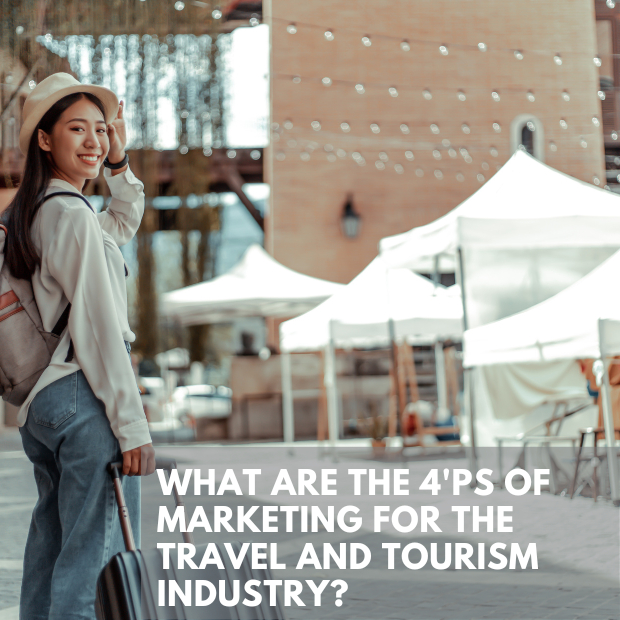

The 4 P’s Of Marketing For The Travel And Tourism Industry
The travel and tourism industry is highly competitive. Differentiating yourself is key to rising above the marketing clutter and noise. Often times keeping things simple is the best way to gain focus and clarity about your marketing strategy. The 4 P’s of marketing in the travel and tourism industry is good start.
These four factors are part of a tried-and-trusted method for addressing your branding, promotions, social media, and digital marketing. To find out what they are and why you need them, read our short guide below.
The 4 P’s Of Marketing In The Travel & Tourism Industry
Product, Price, Place, and Promotion are the four key points in any tourism business’ marketing strategy.
Unlike other businesses, where the product is a material item or tangible thing, the products in a travel company are not. But the basic aim is the same: Providing a product that people want. In other words, is there a market for the product that you are offering?
The tourism industry is extremely competitive. You need to set yourself apart from the rest while providing a relevant product. Examples are women’s solo travel or LGBT tours. It helps to target specific categories and niche markets, although this also narrows your target market considerably.
In smaller and localized businesses, this requires careful and in-depth research of the needs of the community where you are based. Is the community that you are aiming this product at able to afford it? Have they expressed a desire for such a travel service or tour?
If you are a larger business with a national or even international customer base, the same principles apply. Are there travel trends that other travel companies or tour organizers are not effectively tapping into?
The more unique your product, the more careful you must be to establish its relevance.
Where do customers go to interact with your brand and order your services or purchase tour packages? For many of you, this may be a combination of physical offices and an online presence.
Whether you have a physical office or not, you more than likely have a website, and possibly one or more social media platforms. Social media marketing is one of the most effective forms of digital marketing .
More and more businesses in the tourism industry are realizing the benefits of social media marketing. But the most important thing to remember is to be consistent. Update your social media pages and web content regularly, with engaging and relevant posts.
Keep your target market in mind when choosing a platform. They appeal to different audiences and choosing the wrong one could be a costly mistake.
Price is a major factor in your marketing success and the success of your business as a whole. Competitive pricing is essential if you want to attract new customers.
So do the groundwork and discover what other tour companies are charging. Read their customer reviews and find out what people think of their pricing. This can give you an indication of what customers would be happy to pay.
But don’t fall into the trap of undercutting your competitors by too much. This may seem like a good idea, but many consumers are wary of what seems like “too good a deal”. Too low a price can actually make new customers reluctant to try your product/service.
Aim for the same price range or just slightly lower than your rivals charge for similar tours and travel packages. A special price for first-time customers or a discount for groups of a certain size may be better ways to have the edge.
The final P of our 4 P’s is promotion, and it ties in with the other three. You can have the right product, the best price, and the relevant place to market your offerings yet l not make a big impression. Want to know why? It’s because, in such a highly competitive market, you need to go one step beyond.
The best way to do that is through promotion.
Promotions entail more than just advertising a great deal. It’s about getting your brand out there and attracting new customers.
Introductory offers and limited-time-only value-added tours will all attract new users to your platform and create interest in your brand. Partnering with social influencers can also make a big impact on a younger audience.
With an effective multi-pronged marketing campaign that includes digital marketing, social media, and mainstream traditional media, you can’t go wrong.
Emphasize what is unique about your company. A catchphrase that resonates with the travelers’ goals will add extra punch.
Final Thoughts
With these 4 P’s of marketing, you can make a success of any marketing campaign for your travel company or tour business. They will help you to put your customer first while increasing brand recognition and industry relevance.
- Recent Posts
- Key Elements For Leaders During Challenging Times - September 18, 2023
- 6 PR Trends For Your Brand In Q4 And Beyond - September 8, 2023
- What You Need To Know About Generative AI Prompts For Public Relations - September 1, 2023
Related posts
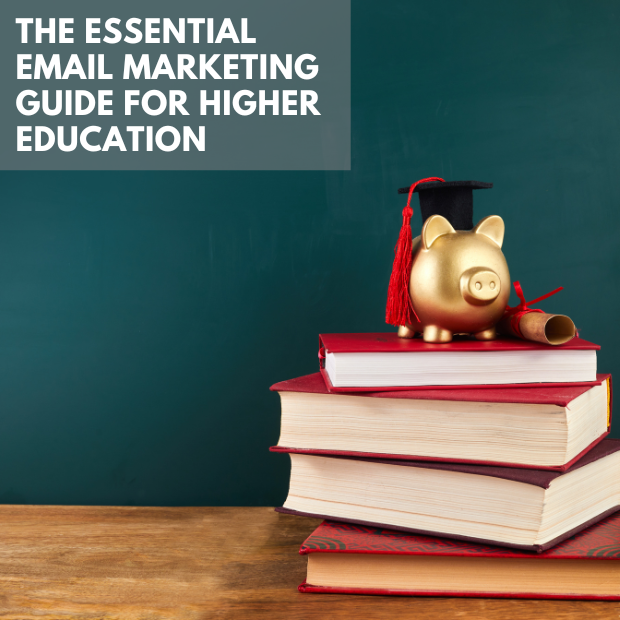
The Essential Email Marketing Guide for Higher Education

The Importance Of Authorship In Travel Brand Content
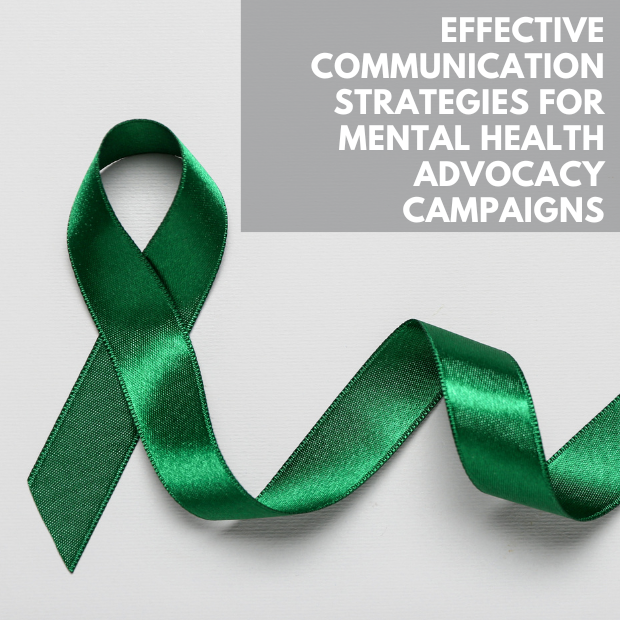
Effective Communication Strategies For Mental Health Advocacy
How can we help.
- Strategic Communications
- Social & Digital Media Strategies
- Crisis Communications
- Targeted PR
awards and accolades
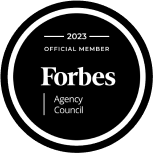
A strategic public relations & integrated communications agency, THO as been offering strategic insight to clients across the nation for more than 25 years.
Privacy Policy
Subscribe to our newsletter
Copyright © 2024 Hoyt Organization

Travelers’ Journey, Personas, and the 4Ps of Tourism Marketing Mix

Research has shown that the tourism sector will become increasingly hypercompetitive after the COVID-19 pandemic. Therefore, consistent promotion with a marketing mix is a realistic and fresh approach to achieve tourism goals.
Understanding audience personas and processes through their mindset is necessary, using a precise method that employs the concepts of attention, inspiration, desire, action, and loyalty. These personas and processes are essential for tourism and travel companies.
Only 27% of the companies in the tourism sector have documented their content strategy at every stage of the traveler’s journey. Thus, the “attention–inspire–desire–action–loyalty (A-I-D-A-L)” method may help inform your travel and tourism content planning with purpose and later promote your content on various channels and networks.
The top three advanced personas are enthusiasts, planners, and adventurers. These three personas (or imaginary individuals) correspond to the essential segments that we aim to attract, including luxury travel, leisure, and business travel . They will help us visualize the targeted travelers and develop brand messages and digital marketing tactics that will resonate with them.
How can you connect with enthusiasts? Enthusiasts are always open to destination discovery and exploration. They are thrill-seekers and want to get away from it all. To reach out to this cohort, you need to take the time to document your content by using the attention–inspire–desire–action–loyalty method.
You can enhance the awareness that an enthusiast has of your travel and tourism brand through all the types of content that you are producing. Create content based on their demographic profile to gain their interest in your tourism campaign. Appeal to them with vivid stories through your persuasive messaging, thereby motivating their purchase desire. Showcase your content on every digital platform so that they can take action and envision their vacation to a bespoke destination. Gain their loyalty by offering reward programs, travel passes, and memberships and, most importantly, by communicating with them regularly through email newsletters.
Enthusiasts may not have a particular destination in mind and could consider your expert suggestion.
Digital Marketing Mix to Engage Enthusiasts
- SEO-based posts that inspire the discovery of new destinations, brands, and activities
- Social media photos showcasing properties, suites, and adventure options
- Branded PPC campaigns to increase demand around the destination or property
How can you connect with planners? Planners are always prepared for activities, and their travel experience begins online. They may create entire itineraries, find deals, and choose the package options to shop from based on their interests and comfort levels. Moreover, for planners, a similar A-I-D-A-L method would be used to document their content strategies.
Enhance planners’ awareness of your travel and tourism brand. Drill down content based on their demographic profile to gain their interest in your tourism campaign. Appeal to them with vivid stories through your drive, creating a desire in them to purchase your product. Use your most compelling content on every digital platform so that they can take action and envision their vacation to a bespoke destination. Obtain their loyalty by offering reward programs, travel passes, and memberships.
As a result, planners’ expectations will increase, and they will plan their trips from the outset.
Digital Marketing Mix to Engage Planners
- Create “checklist posts” to help them prepare for a specific trip
- Showcase advanced photographic ideas on social media channels to inspire them
- Customize a campaign to show safety protocols and comfort levels to help them prepare in advance
How can you connect with adventurers? Adventurers have a powerful travel persona and can be great advocates of tourism and prolific sharers of knowledge. They have an overpowering lust for the outdoors and a burning desire for adventure travel. They always have a list of adventures to embark upon for their next trip. Further, for adventurers, a similar A-I-D-A-L method would be used to document their content strategies.
You can make adventurers aware of your travel and tourism brand. Produce content based on their demographic profile to pique their interest in your tourism campaign. Appeal to their purchase desire with vivid stories. Use your content on every digital platform so that they can take action and envision their vacation to a bespoke destination. Obtain their loyalty by offering reward programs, travel passes, and memberships and, most importantly, by communicating with them regularly through email newsletters.
Adventurers are in love with adventure travel. They chase it around the globe and plan on having a good time experiencing the best adventures on the planet.
Digital Marketing Mix to Engage Adventurers
- SEO-based posts highlighting the best adventure destinations
- Photo collateral in HD showcasing physical activities and adventure options on social media channels
- Creative YouTube video ads with experiments and sequencing showcasing adventure moments
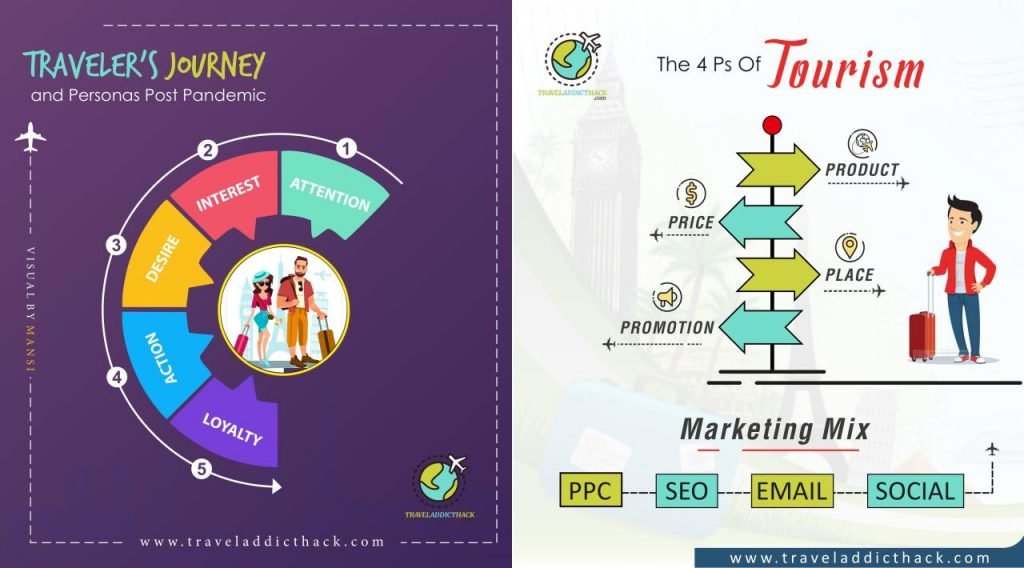
Use the 4Ps model in travel and tourism to connect with each individual The 4Ps in tourism are “product,” “price,” “place,” and “promotion.” They are intangible factors for enthusiasts, planners, and adventurers and are categorically streamlined as follows.
Product: Tourism involves components ranging from the niche to mass appeals, such as accommodation, food, beverages, transportation, scenic beauty, the historical significance of places, geographical state, and concerts like Coachella, Woodstock, and Sunburn. These attractions can appeal to travelers in each segment of the tourism market. However, the packaging of your offering is also essential, and every element is intangible and must heighten the tourist’s experience.
Price: Price is a significant factor in the 4Ps of travel and tourism. All tourism products are unique. The tourism business is seasonal in many countries. Thus, price setting based on market competition is a critical component of the experience that travelers require. Their expectations must be met irrespective of whether they are paying modest, standard, or expensive.
Place: Distribution in tourism is a tricky process, whether it takes place online or at shop fronts. Technology has played a pivotal role in the growth of the travel industry, especially with the COVID-19 situation, in terms of sustainability, design, and security.
The real value of innovative marketing is obtaining suitable packages at the right time in the right place. Thus, the location from where you conduct your travel and tourism business requires a proper evaluation. For example, consider your audience—are they offline or online shoppers? Therefore, research is the key to finding the correct place; consider your competitors’ actions in specific locations.
Promotion: In tourism, the promotional activity consists of inspiring, educating, persuading, and reminding the travelers about the brand or product. It refers to the marketing tactics employed to spread brand or product awareness. Various digital channels, including traditional, OTT, and CTV devices, are used in the tourism industry. The attention–inspire–desire–action–loyalty method will help you find your target audience and promotional strategy and campaigns. Different demographic segments may have varying responses to your marketing efforts. Therefore, consistent promotion must be realistic throughout the traveler’s journey.
These 4Ps can be mixed and merged beyond imagination in any marketing mix strategy.
This article presents a comprehensive overview of the types of audiences searching for travel and tourism information that can help you plan your campaign accordingly and promote it on various channels and networks.
If you are looking for help in developing a content strategy and campaign that furthers your travel and tourism business goals , feel free to contact me today at [email protected] , and let’s discuss your project. For more information, visit TravelAddictHack.com or get social on Instagram and Linkedin .
The author is an analytical thinker and blogger.
For any enquiries email us at [email protected] or phone us at +1 561-203-0855
Ⓒ 2022 - All Rights Are Reserved

Your Marketing Mix: the 7 Ps of Travel and Tourism Marketing

As a busy tour operator, developing a marketing strategy for your tour or activity business can feel like a daunting task. You already have your hands full ensuring your business is running smoothly, you can’t afford to waste time or money on the wrong things. Fortunately, you don’t have to go in without a plan. A good way to build out your knowledge of the fundamentals of marketing is to understand the marketing mix and how to use the 7 Ps of marketing in the travel and tourism industry.
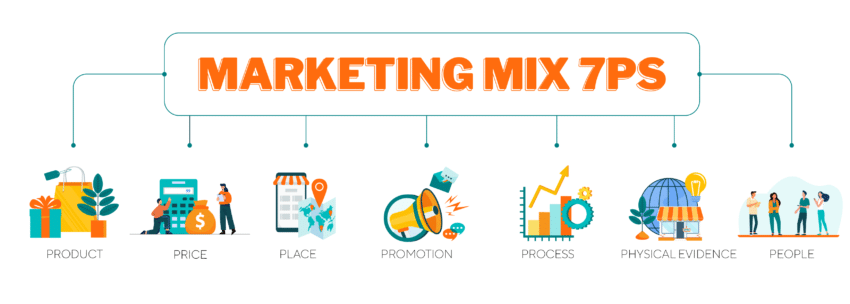
A marketing mix is the set of actions that a business uses to promote its brand in the market and influence customers to purchase their product. An effective marketing mix focuses its efforts in multiple areas to build a robust marketing plan. These areas were initially known as the 4 Ps of marketing (product, price, place, and promotion) and were first proposed by marketing professor Jerome McCarthy in 1960. Since then, marketing tactics have evolved and in an attempt to better address businesses in the service industry, the 4 Ps were expanded to 7 and now include people, process, and physical evidence.
Why Do They Matter?
Today, we’ll be exploring all 7 Ps of the marketing mix and how they can help you build an effective marketing strategy for your tour or activity business. While each element of the marketing mix is important on its own, collectively they provide a framework for creating a plan that is unique to your business and your target audience. Following the 7 Ps will help you better understand your brand so that you can develop a marketing strategy that works for you on all fronts.
The 7 Ps of Travel and Tourism Marketing

The first P of the marketing mix is product. That is, what is it that you’re selling to your customers? In most industries, the product is something that is tangible. The customer can walk into a store, purchase a product off the shelf, and take it home with them. However, in the tourism industry, the product provided is often an intangible service in the form of a tour, an experience, or even the destination itself.
Tangible or intangible, to give your product the best chance of success, it’s important to ensure that there is a demand for what you’re selling. Make sure you have a thorough understanding of the service you’re offering, the needs you’re fulfilling for your customers, and why they aren’t able to get it anywhere else. What makes your tour or activity unique and better than that of your competitors?
Answering these questions will help you discover your unique selling proposition (USP) and determine your positioning in the market. Above all, ensure that the tour or activity you’re providing is the best that it can be.
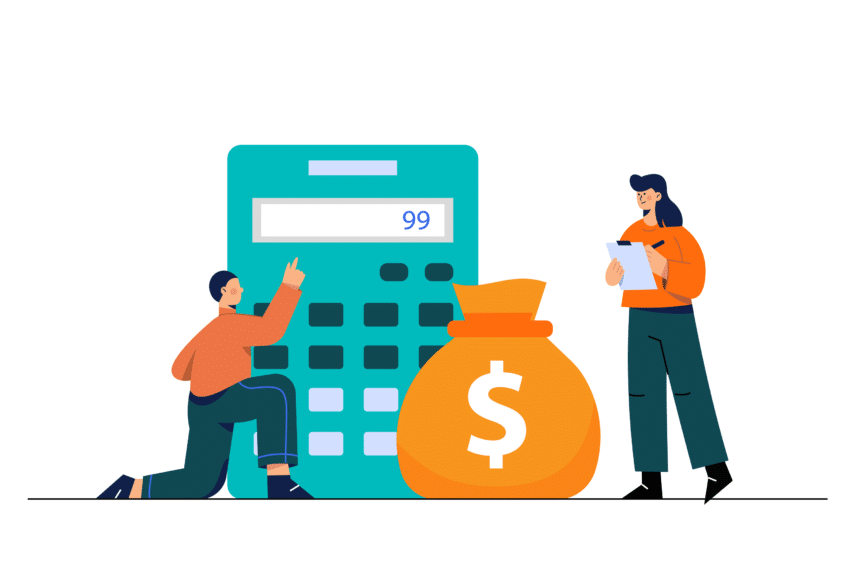
Next up is the price of your tour. What are your customers willing to pay for what you’re offering? Determining how to price your tour or activity package requires the careful consideration of factors such as competitor pricing, the budget of your target audience, and your own overhead and operational costs. Ultimately, you want to price your tour or activity competitively so that it is both attractive to your customers and profitable for your business.
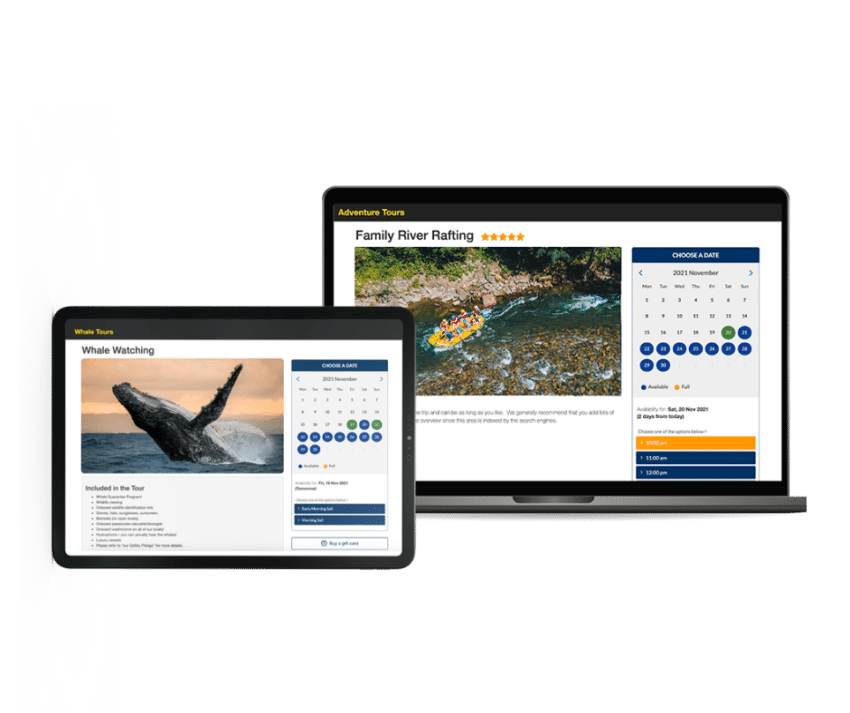
The third P of the travel and tourism marketing mix is place, or the distribution method of your product. This is where and how you make your tour or activity available to your customers for purchase. As mentioned earlier, because the service you’re providing is intangible, the places where your customers can book your tour will primarily be online, whether it be through your booking website, social media platforms, or online travel agencies (OTAs) like Expedia and Booking.com.
Your online booking website is one of the most important places your tours and activities can be found, so make sure it’s doing everything you need by booking a demo with Rezgo .
Physical locations like your tour or activity office as well as neighboring businesses that you’ve partnered with are also places where your customers might access your product.
The last of the original 4 Ps of marketing is promotion, or how your customers learn about your tour or activity. Tour promotion encompasses all the tactics that businesses typically use when they think about marketing. This includes both physical and digital advertisements, social media posts , press releases, events, special deals or limited-time offers, customer reviews, and partnerships with hotels or other local businesses at your destination. The possibilities are endless when it comes to tour promotion and are really only limited by your own creativity.

The people who represent your business and the customer service they provide are especially important when it comes to the success of a tour or activity company. Unlike businesses where physical products can sometimes speak for themselves, the overall experience a customer receives on a tour is greatly influenced by the people they interact and engage with. This includes tour guides, customer service representatives, and even booking agents. To ensure a positive experience for your customers, it’s important that anyone who interacts with your customers on your business’ behalf (even indirectly) is highly professional and knowledgeable about your products and services.
the sixth of the 7 Ps of tourism marketing is the process. The process that a customer goes through from the moment they book your activity to when they finally complete the tour should be as pleasant, convenient, and seamless as possible. Customers should be able to access any information they need with ease including their itinerary, booking info, waivers, etc.
Just as important is how your business decides to deliver this information to your customers. Plan and design your process so that it is easily replicated for efficiency, reliability, and consistency. A good booking system can automate a lot of your process to make sure the customer experience is smooth and efficient from start to finish.
Physical Evidence
Lastly, we have physical evidence. Once again, because the experiences and services provided by a tour or activity company are usually intangible, it can be difficult for interested customers to try them out before committing to a purchase or booking.
There are, however, still ways for tour operators to use physical cues to help convert potential customers. Some of these include website design, physical tour office layout, employee uniforms, brochures, marketing material, and souvenirs or free swag. It’s also worth highlighting any tangible elements of your tour that customers can look forward to in your promotional material or tour descriptions .
Measuring the Success of Your Travel and Tourism Marketing Mix
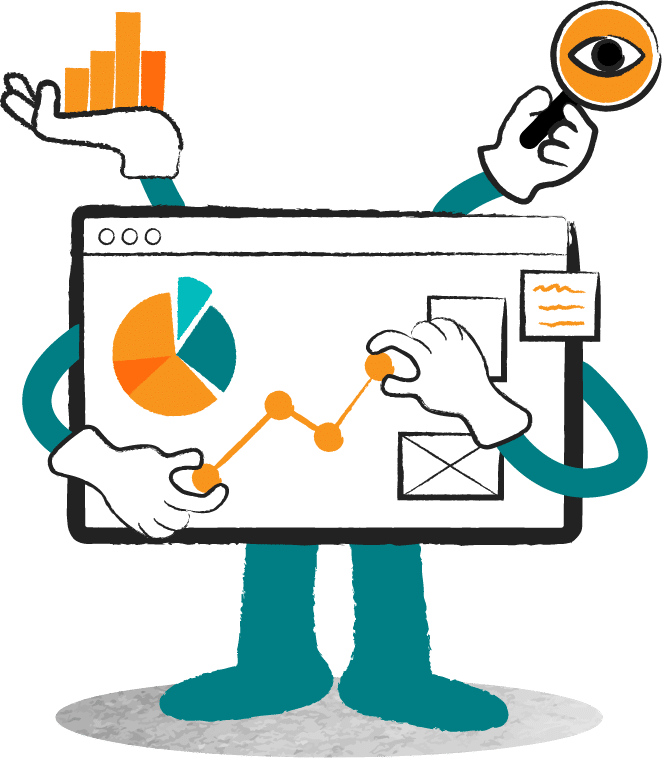
Using the 7 Ps of marketing to build out a strategy for your tour company is great, but how do you know if it’s working? Measuring the success of your tourism marketing mix can be accomplished in a few ways. The first is to calculate your return on investment (ROI) to determine whether the money you’ve spent on your marketing initiatives are actually bringing in enough sales for a profit.
Another way to check on the performance of your marketing strategy is by using analytics on engagement data. How many people actually saw or clicked on that ad, post, or email? How many of those clicks converted into a sale?

Rezgo offers a powerful reporting system that allows tour operators to track the performance of their marketing campaigns and analyze the impact of each referrer or promo code. By studying this data you can adjust your marketing strategy so that you’re focusing your effort and allocating your money in the most effective places.
There’s a lot to consider when developing a marketing strategy for your tour or activity business, but now that we’ve broken down the 7 Ps of a tourism marketing mix, you know exactly which areas you should be focusing on.
Work on planning and building out each marketing element separately, but remember that they need to complement each other and work together harmoniously for the biggest impact. Adjusting your strategy in one area should affect the way you approach another.
Rezgo helps tour and activity providers thrive by giving them the tools and guidance they need to work efficiently and expand their business.You’re passionate about providing amazing experiences. We’re passionate about building flexible tools to make your job easier and get you more bookings. Let’s work together to make your business thrive. Start using Rezgo today by signing up for free !
We can’t wait to see you launch your next marketing campaign. Good luck!

Written By | Edward Nieh
Edward Nieh is a freelance writer and copy editor working across multiple mediums for clients from various industries. He has a degree in creative writing with a focus on screenwriting for feature films.
Previous Article Advantages and Disadvantages of Online Travel Agencies (OTAs)
Next Article Special Interest Tourism: Find Your Niche
Related Posts

Articles , Increase Online Bookings , Tourism Trends
17 innovative tourism business ideas and trends for 2024.

Articles , Increase Online Bookings , Marketing Strategies
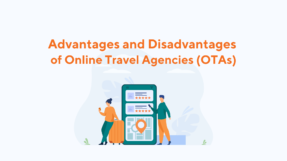
Articles , Increase Online Bookings , Tourism Best Practices
Advantages and disadvantages of online travel agencies (otas), search the blog.
- All Categories
- Increase Online Bookings
- Marketing Strategies
Most Popular Articles
- 17 Innovative Tourism Business Ideas and Trends for 2024 72 views
- Advantages and Disadvantages of Online Travel Agencies (OTAs) 46 views
- Your Marketing Mix: the 7 Ps of Travel and Tourism Marketing 43 views
- How to Create a Business Plan for Your Tour or Travel Company 6 views
- How to Create and Promote Amazing Tour Packages 4 views
I have read and agree to the Rezgo Privacy Policy
GET STARTED
Sign-up for a free demo.
Lorem ipsum dolor sit amet, consectetur adipiscing elit, sed do eiusmo tempor incididunt ut labore et dolore magna aliqua.
Schedule A Demo

Want to create or adapt books like this? Learn more about how Pressbooks supports open publishing practices.
Tourism Marketing and Promotion
General overview.
Marketing and promotion are essentially figuring out what message(s) you need to sell a product and how to communicate to potential buyers. To use the famous quote from the 1989 movie Field of Dreams “if you build it they will come” is NOT how tourism works, marketing and promoting is essential to be successful. But, marketing and promoting tourism is very different than other tangible products and services. Destination CVBs are marketing and promoting an entire destination with numerous “products” and services.
Tourism Marketing
The American Marketing Association (2022) indicates “Marketing is the activity, set of institutions, and processes for creating, communicating, delivering, and exchanging offerings that have value for customers, clients, partners, and society at large” (https://www.ama.org/the-definition-of-marketing-what-is-marketing/). There are common elements of marketing used for all products, but tourism marketing is unique. In marketing in general there are the common 4-Ps:
- Product – Whatever is being sold (in tourism it is the experience).
- Price – Cost of the product (in tourism it includes everything you purchase for the experience).
- Place – Where you purchase the product. Also known as how the product is distributed.
- Promotion – How the company or organization communicates the product to the consumer(s).
Marketing tourism is very unique compared to other products. Shoemaker and Shaw (2008) provide four primary ways marketing tourism is different than other products:
- Intangibility – Tourism is an experience, not a physical product (e.g., computer). Tourists will have memories of the experience they may share with others (e.g., family, friends).
- Perishability – The supplier cannot stockpile the product and resell it. For example, an empty seat on an airplane cannot be resold on a different flight. Each plane has a limited number of seats. An airline cannot add a seat unsold on the first plane to the second plane.
- Heterogeneity – The experience is not likely to be the same for consumers. Unlike physical products (e.g., computer), tourism experiences cannot be mass produced.
- Inseparability of production and consumption – Tourism experiences are consumed as they are produced. Other products can be produced in one city, state, etc. and sold in another. In tourism, the consumer (tourist) has to go to the product (i.e., destination). With tangible goods they can be purchased in a store and taken home or shipped to the consumer.
For tourism marketing there are an additional 4-Ps (Morrison et al., 2018):
- Packaging – A way to purchase some, many, all of the tourism product together (often through intermediaries such as Travelocity, Expedia, etc.).
- Programming – Ability of the destination to change themes, delivery of the product, and when the programs are available (e.g., destinations may have a special program around certain holidays).
- People – Tourism focuses on people. Destinations strive to provide a good experience and people are needed who can provide the experience. Although technology is changing some aspects of tourism, people will likely always be required.
- Partnerships – When businesses, organizations, etc. work together or collaborate deliver the tourism experience.
Marketing Orientation
Marketing orientation is essentially a guide for marketers. Morrison et al. (2018) suggest the following orientations
- Production – Focuses on what the product is and how it might fulfill needs and expectations of tourists.
- Sales – Focuses on selling more. So, increasing the volume of travelers, getting day-trip tourists to stay overnight are two examples of selling more.
- Marketing – First the needs and expectations of tourists are identified. Then, marketing tries to find a way to fulfill those needs and expectations.
- Societal – This orientation considers the society and local community and finds sustainable and/or responsible ways to market. This is a perspective or orientation that can minimize the negative social/cultural impacts.
In addition and similar to other topics covered (e.g., planning, development), marketing needs to be adaptable. Remember, tourism is season in many destinations, which might mean different target markets, different programming and events, and other issues to consider. As discussed from several perspectives, marketing needs to be adaptable because of challenges such as the economy, natural disasters, and other challenges.
Market Segmentation
Market segmentation in tourism is a way to group tourists according to characteristics they have in common since they are not exactly alike (Morrison, 2010). Some of the simple ways to segment the tourism market includes by demographics (e.g., age, household income, education, marital status). However, by combining such variables and looking at life cycle tourism marketers can be much more targeted and strategic. Another important consideration is geographic, or where actual and/or potential tourists reside. Another option is purpose of trip (e.g., business or leisure; group, family, individual). Behaviors of travelers can also be used to segment tourists. For example, marketers might segment based on travelers’ motivation or benefit they seek from taking a leisure trip/vacation. Psychographics (e.g., attitudes, interests, opinions) is a valuable segmentation tool which Strategic Business Insights (2009-2023) uses to group travelers into lifestyles (there is a survey you can complete to find out what type of VALS traveler you are) .
An example of segmenting a group of travelers is Shoemaker’s (1989) study that segments based on senior travelers reasons for traveling using cluster analysis, which is a statistical technique to segment a sample into groups based on a set of survey questions (Brochado, 2021). Shoemaker (1989) segmented based on reasons seniors traveled, including rest/relaxation, festivals/special events, experience new things, visit new places, escape daily routine, intellectual, and a number of other items. This study identified that there are sub-markets of the broader senior travel market. For example, Shoemaker (1989) identified three clusters: “Family Travelers” who enjoy spending time with immediate family; “Active Resters” travel to escape daily routine, intellectual enrichment such as visit historical sights, and participate in physical activities; and “Older Set” whose main differentiating characteristics is they are older then the other two groups and enjoy staying at all inclusive resorts, and participating in activities such as visiting historical sites.
When selecting target markets there are several criteria to consider according to Morrison et al. (2018). First, the need to be measurable, meaning you can estimate how many exist in the target market. This is essential because you want your broad or mass marketing to reach a sizable number of potential visitors. Next, the target market(s) need to be accessible, meaning you can reach them with your message. The next criteria is they need to substantial enough to justify the time and money that will be spent. Fourth, the target market(s) need to be defensible or make sense that they are likely to visit. The defensible criteria includes recognizing if they are a separate target market than other target markets or are they enough alike another that they are not truly distinct. Durability of a target market implies they will continue to exist over time and not just be a short-term or one occurrence. The destination also needs to ensure they can compete with other destinations for the target market. Homogeneity of the target market is the criteria that there are enough similarities with the target market. Finally, each target market needs to be compatible with the other target markets, as well or residents or locals to minimize negative social/cultural impacts.
Morrison et al. (2018) also identifies concerns the destination needs to consider when identifying target markets. First, do they have enough income to travel now and in the future and will they potentially spend enough money at the destination to make they a worthwhile target market. The destination also needs to be confident they can be competitive with other destinations marketing to the same or similar target markets. Another important concern is to ensure the investment needed to offer the product(s)/service(s) to attract the target market and to market/promote to them is worthwhile. Finally, does the destination have sufficient financial and other services to design and promote at necessary levels.
Destinations should also consider internal marketing within the destination. This includes to members of a CVB and/or other businesses within the destination system. Other internal stakeholders should be included such as politicians and community leaders, service providers (e.g., police, fire, EMT/healthcare) who are included in the important infrastructure component of a destination system. External marketing should not only done for visitors, but also intermediaries, suppliers, media, and other potential groups who can help with a destination’s efforts.
Branding and Positioning
Branding is applied quite a bit for products and services. However, in tourism it is more complex to brand a destination. Until relatively recently, CVBs would use the full phrase and/or acronym in the name of the organization (e.g., Greater Houston Convention and Visitors Bureau). These long and often similar names for the organizations could make it difficult to differentiate from other destinations. Many CVBs began developing shorter, more attractive names such as Visit Houston and have various logos and other branding to differentiate themselves from competitors.
A key element of branding, logos “can facilitate many DMO marketing activities to establish brand image and identity, particularly relevant before the actual visitor experience” (Blain et al., 2005). Branding is critical for developing a destination’s image because of increased competition among destinations (Jetter & Chen, 2011). Branding and brand identity help a destination position themselves or establish an image as a travel destination.
All brands have a value generated by the name, icon, or other identification, which represent brand equity. Williams (2021) the brand equity concept is complex. For tourism with so many stakeholders involved it is way more complex than single brands. So, destinations need to figure out what represents the overall tourism product of their destination. Kim and Lee (2018) found that characteristics such as price and work of mouth influence perceptions of perceived quality, brand awareness and image, which then help a destination’s brand equity.
Marketing Plan
Within a destination’s marketing plan should be both strategic and tactical elements (Morrison et al., 2018). Strategic activities are more related to long-term goals, which might include developing relationships and or partnerships with and between tourism related organizations (e.g., CVB, sports commission, hotel association, etc.). These types of strategies help a destination be cohesive and develop long-term value, which can lead to repeat visitation. The relationships and partnerships can help a destination manage the impacts (i.e., economic, environmental, social) as well. The tactical elements are shorter term, but help the destination with long-term goals. Examples include public relations campaigns, social media efforts, and the foci of convention and meeting sales, which can include booking short-term meetings to fill in the gaps for the destination around larger conventions, trade shows, and other large events that are booked and confirmed much further in advance.
The marketing planning process as explained by Morrison et al. (2018) should address the following questions:
- Use situation and or SWOT analysis (i.e., strengths, weaknesses, opportunities, threats). This analysis(es) should consider who current visitors are, what the destination offers. To reflect how all of the modules for this class interact, a destination might identify an opportunity to develop a new attraction. Also consider environmental scanning, which assesses legal (e.g., travel restrictions), technological (e.g., smartphones), accessibility to and within the destination, economic, and macro-level competition for consumers discretionary income.
- Evaluate the entire tourism system components (i.e., attractions, facilities, infrastructure, transportation, hospitality)
- Assess visitor market, including current target markets, as well as potential target markets.
- Compare and contrast the destination with competitor destinations, which can include but not limited to their image and their marketing plan.
- Through out all this process strengths and weaknesses should be clearly identified. Through weaknesses a destination might identify opportunities or things that can be done better.
- Vision and mission statement. The vision statement is very much future oriented. The mission statement is essentially what the organization does and its’ values.
- Establish marketing goals to get to where the destination would like to be, which might include number of visitors, economic impact, visitor satisfaction, and/or various other possible ways to measure if the destination gets there. Remember, most or all CVBs are at least partially funded by the hotel occupancy tax, so hotel tax might be a goal to set.
- Using the segmentation ideas and criteria (e.g., measurable, accessible, etc.) above, the destination needs to identify target markets.
- Create – if destination does not have a positioning approach.
- Change – if positioning has not resulted in the desired image the approach likely needs to be changed.
- Reinforce – perhaps target markets have forgotten or the image they have of the destination is not as strong as it used to be. In this case finding a way to reinforce or remind visitors is needed.
- Establish objectives that the destination can measure, including within target markets. These should be very specific and result from all the analysis performed throughout the marketing planning process.
- By implementing the marketing plan. Typically have sub-marketing plans for each target market because of various potential differences between them. The differences would include the marketing mix or 4-Ps of marketing (i.e., product, place, price, promotion).
- Monitor along the way so the destination can adapt if needed. Remember the objectives are stepping stones toward the longer term goals. So, if objectives are not being achieved something(s) likely need to be adapted.
- Research and statistics. It depends on what the measurable goals (and objectives) are as to how to measure.
Tourism Promotion
Promotion is essentially communicating or making consumers aware of a product, which can be verbal, written, and/or visual. Walker and Walker (2018) provide sequential steps of how promotion affects the buying process labeling each with one word descriptions:
- Provider creates awareness of the product to consumers (awareness).
- Consumer needs to become aware of how the product will fulfill or affect their needs (knowledge)
- Hopefully this knowledge creates a positive disposition for the product (liking).
- Hopefully the positive disposition lead to the consumer preferring the product over those of the competitors (preference).
- Finally, this should increase the probability of the consumer purchasing the product (probability).
Remember, the tourism product is very different and more complex than other products. One, the product is intangible and two it is derived of many aspects (i.e., attractions, accommodations, built facilities, transportation, infrastructure, hospitality).
Since promotion is a communication tool, there is a sender and a receiver. The sender for destinations as a whole are typically the CVB or DMO and the receivers are potential travelers/consumers. Messages/promotions can be sent through a variety of channels (e.g., billboards, television, newspaper, magazines, internet, email newsletters, etc.). However, not all promotions reach the intended recipient(s). Morrison et al. (2018) explains the following issues related to promotions and reaching the intended recipient(s):
- Barriers – ways consumers can block messages, such as Do Not Call Registry and recording television shows to be able to fast forward through commercials.
- Filters – deleting emails from companies and people not known to the recipient.
- Noise – any distraction keeping the recipient(s) from the promotional message.
- Permission – can be explicitly or implicitly. An example of explicitly is subscribing to a CVB e-newsletter. An example of implicitly is the organization pays for a message, such as on Facebook or a television commercial.
Morrison et al. (2018) also suggest even if the intended recipient(s) receives the promotion, it does not mean they hear, understand, and/or believe the message. It is important to send a message that people can understand and is realistic or believable. Ideally, the sender of messages will be able to receive feedback from the recipient(s). For example, number of recipients who click a link to get more information, number of sales of the product, a follow up survey to find out what the recipient(s) thought of the promotion to name a few.
Promotion Goals and Types
There might be various goals a CVB or DMO has for their promotions. One very obvious goal is to get consumers to purchase or book a trip. Other potential goals would be to entice travelers to upgrade to more expensive packages, stay longer, convert day visitors to overnight tourists, and be repeat visitors. In order to potentially achieve these goals it is important to understand the visitor buying process in order to establish goals and to influence purchasing behaviors. Inherently, consumers need information to consider any purchase, including travel. The general consumer decision-making process according to The Sales Optimization Company. (2009-2022) includes the following stages:
- Awareness – consumer becomes aware they need a product, in the case of leisure tourism it could be a weekend getaway, family vacation, a day trip to a community event or other activity in another destination than where they reside, and many other possibilities.
- Research – the consumer will search for information about possible options. A destination should have their promotional materials in multiple sources to be as visible as possible.
- Consideration – the consumer through the research stage may have numerous possibilities to consider.
- Conversion – the purchase decision is made. This could include deciding not the take the trip, perhaps for various reasons (e.g., do not have enough money for the desired trip).
- Re-purchase – consideration if the trip or product fulfilled their need and would buy again, or take a trip to the same destination again.
Morrison et al. (2018) suggest thee are three goals of promotions. You might also consider these strategies to try to modify consumers’ behaviors. The first is inform, which is relevant for the awareness and research stages of the consumer decision-making process. Next is persuade, which is relevant to the consideration and conversion stages of the consumer decision-making process. Last, remind is a strategy to use as consumers contemplate the potential re-purchase stage of the consumer decision-making process.
Promotional Tools
The ‘place’ component of the 4-Ps of marketing provide what Morrison et al. (2018) refer to as ‘the promotional toolbox’. Many references (e.g., Morrison, et al., 2018; Walker & Walker, 2018) regarding promotional tools highlight and explain the following
- Advertising -primary source for promoting to the mass market for leisure travel (e.g., television, magazines, newspapers, billboards, internet (banner ads).
- Personal selling – primarily used to promote a destination for the meetings and events sector where a small number of people decide on the destination and venue, but the event brings many people.
- Merchandising – travelers may purchase souvenirs when they travel. This is a good promotional tool where the traveler pays for it and is a reminder of the trip later one. For example, someone might use a coffee cup from a trip and be reminded of their experience. If it was a good experience it might influence them to consider visiting again. Another example, someone might wear a shirt or hat they purchase from a destination. A friend or even someone they do not know might ask them about their experience. This is free word-of-mouth promotion that a business or organization benefited financially since the tourist paid for it.
- Digital marketing – websites, social media, e-mail, e-newsletters.
- Sales promotion – a form of promotion that is typically separate from the broader advertising that takes place pretty much all of the time. Sales promotion offers an extra incentive to purchase and is more likely for a limited time.
- Public relations – this promotional tool is important because they deal with the media. Think about when large events have been announced for a city, like the Super Bowl or FIFA World Cup. The local news channels might interview someone from the planning committee. A public relations person would handle arranging that and any inquiry from the media.
Planning Promotions
Morrison et al. (2018) suggest there is a “big P” and “little p(s)”. The big P is the overarching promotional plan for the organization, which is derived of the little ps. Examples of little ps will be the convention sales team’s plan, the leisure sales plan, sporting events, any other categories a destination provides or focuses on. Convention sales might be trying to promote a period of time where they currently do not have conventions or meetings and need to fill in the gap. Sporting events might focus on a specific sport.
Promotions Planning Process
Tourism promotions planning process asks the same questions as marketing planning process. Essentially at this stage, you are implementing the marketing plan:
- Where are we now? – this question is guided by identifying target markets and the promotional tools a destination will use to promote to specific target markets. The target markets should include not only different visitor groups, but also travel trade intermediaries, local community, and media/press.
- Where would we like to be? – this question is used to identify or establish measurable objectives (e.g., number of people to click on the promotion icon, number of overnight stays generated). These objectives are specific to the little ps and include goals of the promotion (i.e., inform, persuade, remind).
- This question also identifies the budget for the specific promotion and potential partnerships to pool resources (e.g., funding, talent and knowledge of people).
- This question also helps determine the message idea, which may require research, focus groups, and other forms if feedback to assess consumers’ interest and refine the promotion.
- The message format needs to be created to ensure it is understandable, distinct from competitors, and believable (i.e., destination really can provide what it is promoting).
- In terms of financial resources, there are various measures that help to determine the promotional reach (e.g., cost per contact, cost per inquiry, geographic – how many people in a designated market area you might reach). (There are various others in the PowerPoint we will discuss in more detail, including tradeoffs with specific promotional tools.)
American Marketing Association. (2022). Definitions of marketing. https://www.ama.org/the-definition-of-marketing-what-is-marketing/
Blain, C., Levy, S. E., & Ritchie, J. R. B. (2005). Destination branding: Insights and practices from destination management organizations. Journal of Travel Research, 43 , 328-338.
Brochado, A. (2021). Cluster analysis. In R. P. S. Kaurav, D. Gursoy, & N. Chowdhary (Eds.), An SPSS guide for tourism, hospitality and events researchers (pp. 284-303). Routledge.
Jetter, L. G., & Chen, R. J. C. (2011). Destination branding and images: Perceptions and practices from tourism industry professionals [Article]. International Journal of Hospitality & Tourism Administration, 12 (2), 174-187. http://ezproxy.lib.uh.edu/login?url=http://search.ebscohost.com/login.aspx?direct=true&db=hjh&AN=60294280&site=ehost-live
Kim, H.-K., & Lee, T. L. (2018). Brand equity of a tourist destination. Sustainability, 10 . https://doi.org/10.3390/su10020431
Morrison, A. M. (2010). Hospitality & travel marketing (4th ed.). Delmar.
Morrison, A. M., Lehto, X. Y., & Day, J. G. (2018). The tourism system (8th ed.). Kendall Hunt.
Shoemaker, S. (1989). Segmentation of the senior pleasure travel market. Journal of Travel Research, 27 (3), 14-21.
Shoemaker, S., & Shaw, M. (2008). Marketing essentials in hospitality and tourism: Foundations and practices . Pearson Education, Inc.
Strategic Business Insights. (2009-2023). http://www.strategicbusinessinsights.com/vals/ustypes.shtml
The Sales Optimization Company. (2009-2022). Understanding the consumers decision-making process in sales . https://www.socoselling.com/understanding-the-decision-making-process/
Walker, J. R., & Walker, C. J. (2018). Tourism: Concepts and practices (2nd ed.). Kendall Hunt Publishing Company.
Williams, A. (2021, December 8). What is brand equity? The Branding Journal . https://www.thebrandingjournal.com/2021/02/brand-equity/
GHL 2365 - Tourism Copyright © 2024 by Jason Draper is licensed under a Creative Commons Attribution-NonCommercial-NoDerivatives 4.0 International License , except where otherwise noted.
Share This Book
Make customers come to you
Guide to building 4Ps in Tourism Marketing
- 27 March, 2023

Research has shown that the tourism sector will become increasingly remarkably competitive after the COVID-19 pandemic. Therefore, businesses need to try to find ways to develop businesses to increase the level of competition. Although the 4Ps in tourism marketing is not a new strategy, it is still an extremely effective strategy. In this article CleverAds will show you how to build an effective 4P model in tourism marketing.
1. What is the marketing mix?
To understand the 4Ps of tourism marketing, we need to understand what the marketing mix is. The marketing mix is also known as the marketing mix. This term refers to a set of actions or tactics that a company uses to promote its brand or products in the market.
A typical marketing mix model is the 4Ps consisting of Price, Product, Promotion, and Place. Today, however, the marketing mix increasingly includes several other Ps such as Packaging, Positioning, People, and even Politics as important mix elements.
Read more: What is Marketing Mix?
2. Analysis of the 4Ps in Tourism Marketing
Through the above, this can perceived that 4P is a typical model in Marketing across the industry in general and the tourism industry in particular. Similarly, the 4Ps in Tourism Marketing will also include the following elements: product, price, promotions and location.
2.1. Product
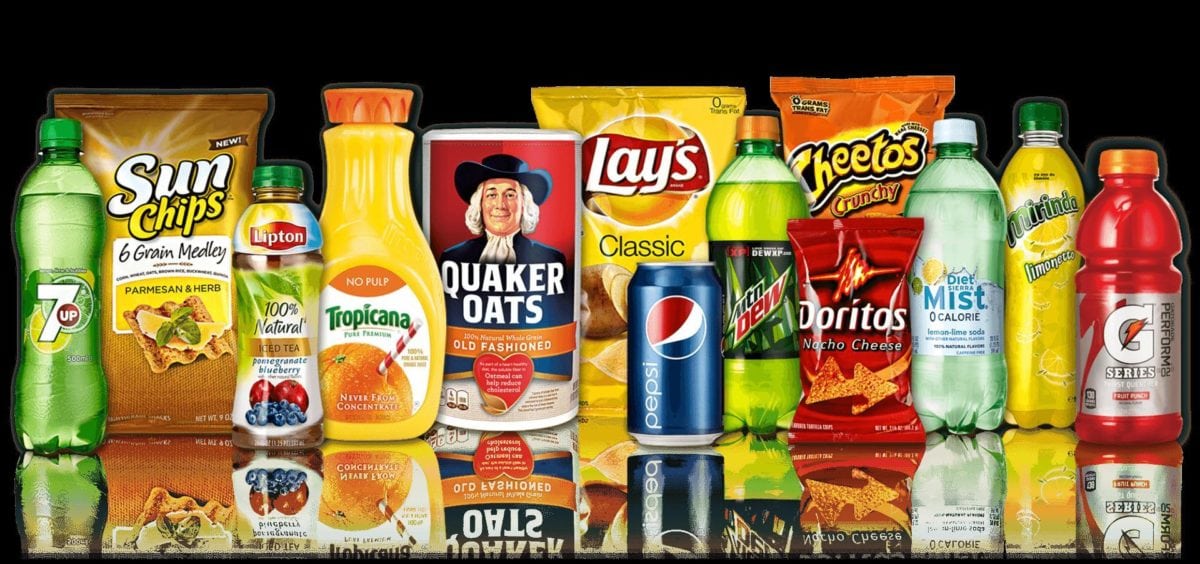
Tourism encompasses a wide range of factors such as accommodation, food and drink, transportation, scenic beauty, the historical importance of the place, its geographical status, and spiritual appeal.
The fact that a destination is considered crucial comes from the customers’ point of view. Not everything is visible in it. It is a combination of tangible and intangible elements. A destination is a “product” in tourism. From the marketing mix point of view, since the travel business is all about the ‘tourist’ experience, this is required to be treated differently.
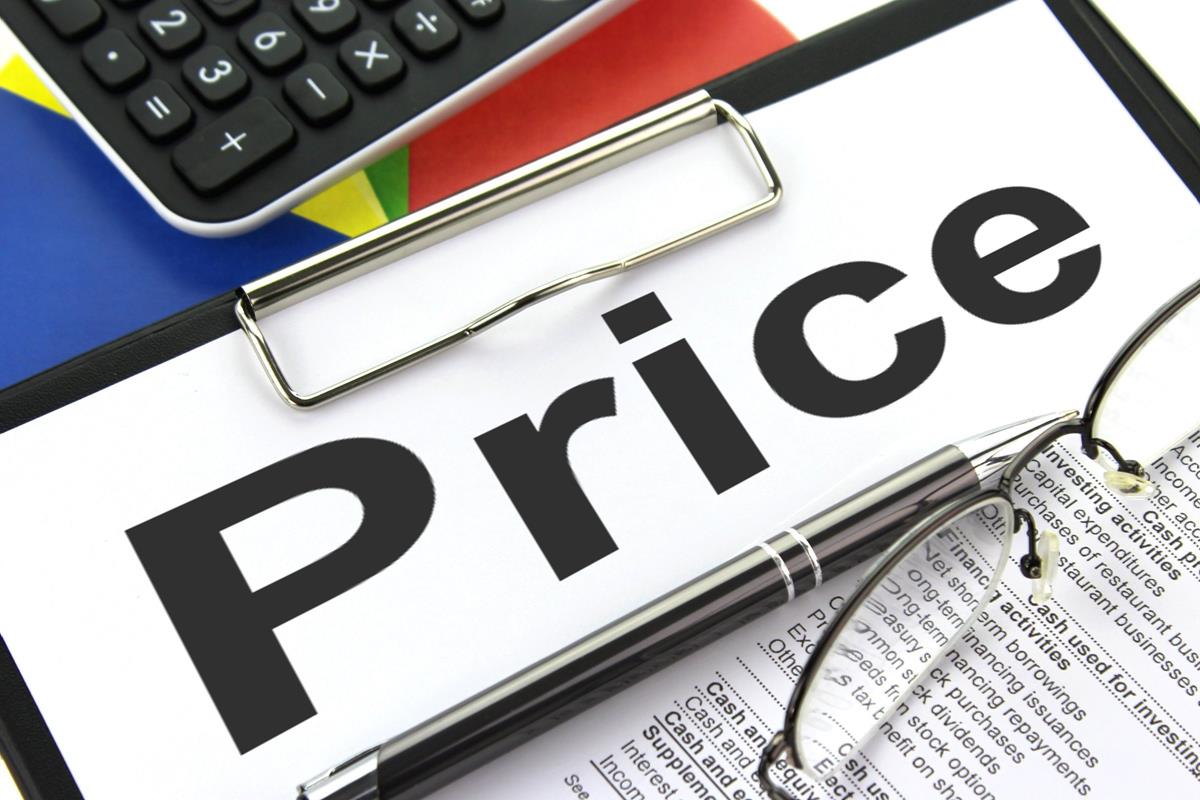
Price is a crucial factor in the 4Ps of travel and tourism. It is the amount that the customer pays for a service package. High package prices, reasonable prices or low prices are all decided by the experienced of the visitor. Pricing should based on provision, accommodation standards, food standards, transportation standards, and entertainment that aspirations met.
That is why some destinations are expensive while others are quietly priced. Tourism products are rarely homogeneous. It is due to different locations, people and other factors that make up the customer experience.
It can be say that in the tourism industry, price competition is not caused by the price but by by-products. It also depends on seasonal factors because the tourism business is seasonal.
2.3. Promotion (Communication)
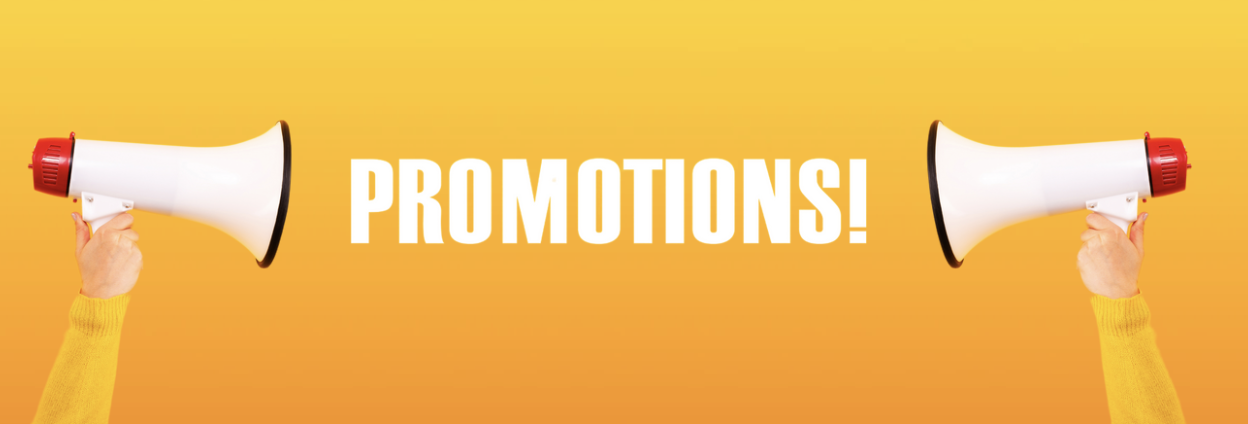
In tourism, promotional activities include inspiring, educating, persuading and reminding tourists of a brand or product. It refers to the marketing strategies used to spread awareness about a brand or product. Various digital channels, including traditional devices, OTT and CTV, are used in the tourism industry.
Enterprises can apply the AIDA model. This model supports businesses in achieving their advertising strategies and campaigns effectively. Different demographic segments may have different responses to your marketing efforts. Therefore, consistent advertising must be realistic throughout the traveller’s journey.
Read more about Promotion at: What is Promotion? All you need to know about the promotion.
2.4 Distribution channel (Place)
In tourism, the distribution aspect seen as very difficult. The link between the travel service provider and the customer called the distribution system. By definition, distribution involves delivering products to customers. It consists of various activities carried out so that the product is accessible and available to potential customers’ at all times.

Tourism is a product or service in the 4Ps of tourism marketing.
Here, customers needs to be taken to different destinations (point of sale). Its channels are tour operators, agents, wholesalers and ITOs (inbound tour operators). For distribution channels in the travel industry, understanding the distribution system, recommended commission rates and the role of agents is important.
Retailers provide customers with an easily accessible destination; online or in-store by pre-ordering travel products. They sell products to customers. Wholesalers are businesses that will sell products through established retail distribution channels both in-store and online on behalf of the service provider.
They also sell individual product elements and associate them with various combos. The role of intermediaries is an important factor in all stages that the tourism industry goes through.
3. Guide to building 4Ps in tourism marketing
When it comes to the 4ps, it’s also time to break them down to incorporate each of these elements into your overall marketing process..
Here is a step-by-step guide to developing the 4Ps in Tourism Marketing
Clearly define the products or services of the 4Ps in Tourism Marketing
It may sound obvious, but before you start developing a marketing mix, it is crucial to have quality products or services. Even if companies have many different types of products, the 4Ps should be applied to each product separately.
Analyze how your product meets the needs of your customers.
Your product should serve the specific needs of your customers. It’s important because it articulates what those needs are and what makes your product or service different to meet those needs. This information will be used when developing a marketing campaign to let customers know what your product does and why they should buy it. You should be able to point to market research and other supporting data to convince them.
Decide on a price for the product.
Rely on market research to properly price your product to attract target customers. Pricing should be based on economic data regarding the client’s budget and spending habits. Some marketers will increase the price of their product to make it seem more exclusive or luxurious.
Build marketing messages.
Develop marketing concepts that will attract customers and communicate the benefits your product offers them. It’s also one of the 4 stages of the marketing mix when you’re deciding what type of marketing communications to invest in. Depending on the product and target customer, your marketing plan can use a variety of channels including traditional marketing methods, direct marketing or digital marketing.
Consider 4Ps in Tourism Marketing as a whole for your product and decide if they fit together.
Now that you’ve created a cohesive marketing mix take a look at each of the 4Ps and decide if your plan is right for it.
Track your marketing strategy in real-time.
A successful marketing strategy requires you to revisit and adjust over time. As a product grows in market share and popularity, the locations and promotional strategies you use should change to keep up with customer needs.
4. Conclusion
This article has presented a comprehensive overview of the marketing mix and the 4Ps of tourism marketing. CleverAds hopes to help you plan your campaign accordingly and promote it across various channels and networks.
If your business requires Digital Marketing solutions, contact us at cleverads.com.ph. for the fastest support.
- Advertising
- Social Media
Navigating the Future: Anticipated Digital Advertising Trends for 2024
- 29 December, 2023
A Vital Strategy for Small Businesses
- 20 December, 2023

- Public Relation
Enhancing Brand Image Through Public Relations
- 11 October, 2023
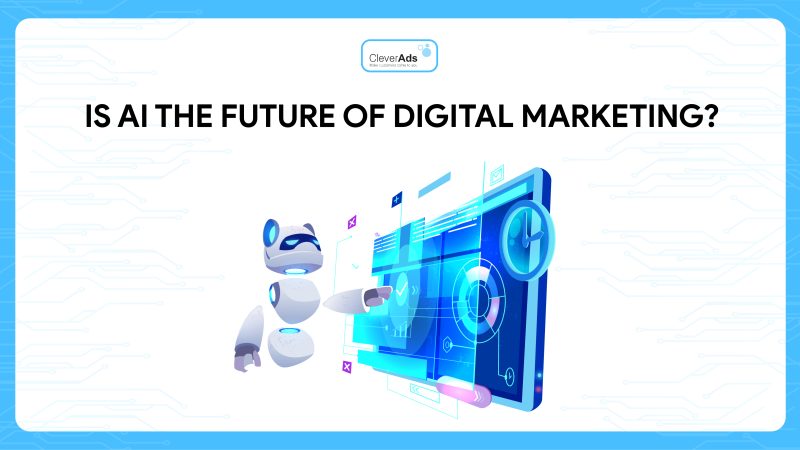
Is AI the Future of Digital Marketing?
- 4 October, 2023
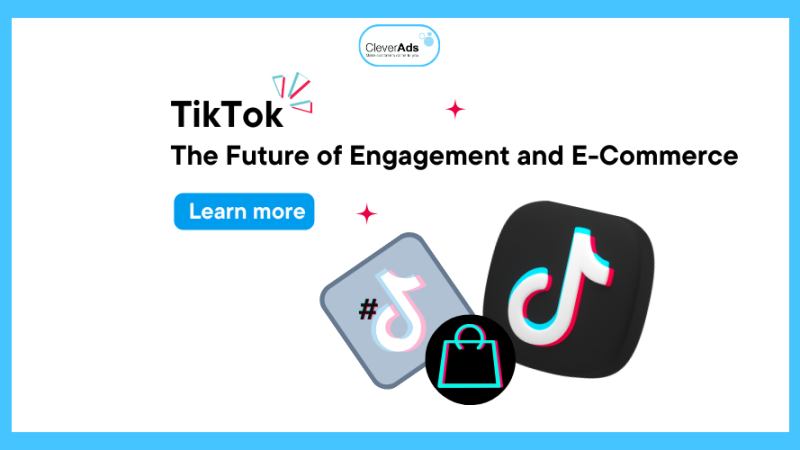
TikTok: The Future of Engagement and E-Commerce
- 26 September, 2023
- Get in touch
- Visit our blog
The Four Ps of Marketing for destinations
Research and analysis + topic: shareable experiences + visitor experience.
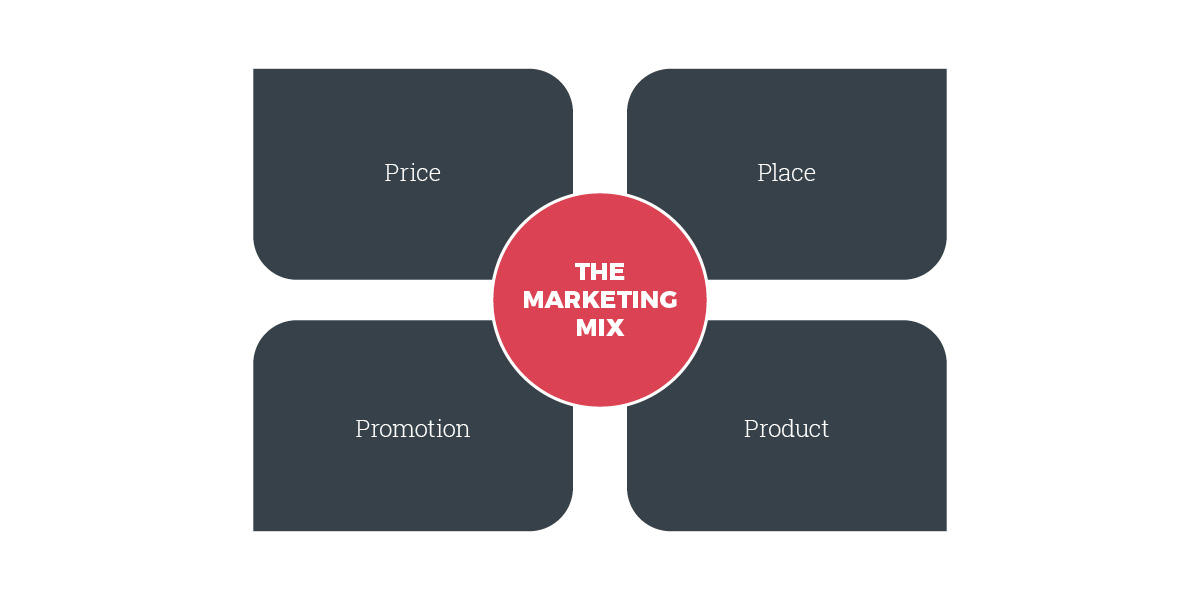
- Recent Posts
- Sharing gratitude for tourism’s positive impact and hope for the year ahead - 23 December 2021
- Why decarbonization will disrupt the future of travel - 27 April 2021
- Solidarity through this defining time: A letter from our CEO - 23 March 2020
13 April 2016
8 comments(s), too many destination marketers confuse “advertising,” “promotion” and “marketing.” don’t be one of them..
Getting the terminology correct will make your investments much more effective.
There has been a lot of discussion in recent years about destination marketing organizations (DMOs) morphing into destination management organizations. While managing the product is becoming increasingly important in driving tourism, misunderstanding the terminology – advertising, promotion and marketing – are often used interchangeably can create confusion about an organization’s objectives. Let’s clear up the semantics.
If you’re well-versed in marketing, you’re undoubtedly familiar with E. Jerome McCarthy’s Four Ps of Marketing , sometimes referred to as “The Marketing Mix”:
Which of the four Ps matters most to a destination marketer? Typically, a DMO has little control over pricing and place . Promotion has changed drastically as a result of technology that accelerates word-of-mouth communication and shifts control over the messaging toward the consumer. For this reason, product is becoming an increasingly critical focus for DMOs; positive word-of-mouth flows freely from visitor experiences that exceed expectations.
Historically, destination marketing organizations have invested heavily in promoting their destination through media relations and paid advertising. Now they must consider promotion through digital channels as well. It’s important to remember, however, that promotion is only one component of marketing – and that advertising is only one method of promotion.
Why is this important?
The experience that a destination delivers can be its most meaningful promotional tool. Destination marketers can no longer assume that promotion (in terms of reaching large numbers through broadcast advertising) is the best investment of their limited resources. Instead, destinations should consider shifting their marketing mix towards product , because improving the visitor experience is the most effective way to super-charge positive word-of-mouth. With the aid of digital communication, a visitor experience begins long before they arrive and can last long after the journey ends. This means that DMOs that default to advertising as their primary method of promotion are missing enormous opportunities to engage their audiences.
Since the word marketing now means something far beyond promotion or advertising, modern destination marketing organizations (with an intended emphasis on marketing) must take responsibility for leading the collaboration within the industry and all stakeholders to define, measure and provide a consistent visitor experience.
More reading related to developing a destination’s product: Design thinking for the modern DMO
Destination Think helps destination marketers and DMOs adapt to change by pairing modern strategy and implementation services with an unmatched global expertise in destination marketing. Stay relevant; contact us to find out how we can help.
The general approach is fully appropriate but lacking since the real conditions are underestimated at large: The expression of “while managing the product is becoming increasingly important in driving tourism” is clearly showing that weare appraching to the problem from ends but not means! The clear merket mistake is: We are trying to sell whatever available in the market for the name of tourism industry and now trying to solve rhe mistakes of ‘industrial production deficiencies’ due to non existence of Destination Management. The first vital aim must be to establish proper DMO (management version) models for destinations to enable a balanced industry, covering prosperious marketing activities. Otherwise, proper macro efficiency and effectiveness cannot be ever reached!
Thanks for your thoughts, Zafer. For many destinations, the shift to a new destination management model is a long journey because different organizations are starting from a different place. Every destination and its tourism board is in a unique position. Some are already excellent at destination management. Others are well-focused on promoting the experiences that truly differentiate their destination. On the other end of the spectrum, other destinations are promoting to mass markets or simply appeasing their hotels and the noisiest stakeholders, which in the long term isn’t doing the destination any favors. One mindset for success is for the tourism board to think of themselves as leaders for their destination and the industry through exciting and collaborative processes. The industry is, afterall, the key ingredient for delivering an experience that exceeds expectations created through any promotions.
Very good point Zafer. Many destinations have certain realities based on the past, and this will continue in the future. Like Rodney said, the DMO needs to take a leadership role.
One example. A leftover from the industrial area is a mass production mindset where products need to be the same everywhere. A McDonalds hamburger is the same everywhere around the world. This is the same with many hotel chains and even smaller tourism operators try to emulate this. But consumers are looking for authenticity. What’s the local flavour of something familiar? Microbreweries, farm-to-table and boutique hotels are examples of trends where uniformity is replaced with local flavours. The same can be applied to any tourism product. Through design, storytelling, staff and more. This is the basis of turning the tourism legacy into unique assets.
Agree Rodney; and using the 4Ps model you could say DMO should just = Destination Marketing Organisation because if they are managing or taking a leadership/facilitation role in all 4 Ps they are already doing Destination Management as “Place”. That’s how I’ve tried to explain it to clients and stakeholders over the last couple of decades. However, as you note, it seems easier for many people to see Destination Management as a new phenomenon and consider marketing as a subset. Whatever helps the stakeholders understand the issues and roles I guess 🙂
I’ve fought that battle over semantics for a number of years and I’m nearly giving up. The word ‘marketing’ is so intertwined with ‘promotion’ and ‘advertising’ in our industry and others that it may not be important to split. If a new word like ‘management’ or experience development’ or ‘destination development’ enables investments in new opportunities, lets not get too hung up on semantics!
Little bit late to react on 2.5 year article buit here I go. Great and concise article, Rodney, and a relieve to again read this between all the articles lately about online marketing, storytelling, ‘place DNA’ , which unfortunately have taken over this site and DT in the last two years. I would like to see more articles like this returnign to this site!
I live in a region where the websites are terrible or non-existent, social media is not used as marketing tool, no DMOs are in place or set up with people who dogmatically think they can actually actively influence a brand by storytelling, branding campaigns etc. (which may work for fast moving concumer goods etc. but not for abstract concepts liek destinations). No products are developed based on ‘destination place DNA’ or suchlike. And still more and more people (continue to) visit this region. How come? The other Ps only: Place and Product and for centuries already (unmanipulated-forced-upon-or-selected-by-DMO) word-of-mouth (we just less and less trust anything coming from DMOs or other formal channels anymore ;)). And according to me it have been, are and will be (always) the collectivity of small and large local entrepreneurs and especially their guests/visitors who take the lead and make or break the visitor experience (here and elsewhere in the world; no DMO can influence this), supported and facilitated by the local municipalities and economic development organisations providing funding for product development (the new role of a DMO for me.
Finally also,could it be that (destination) marketing is more of a thing in Northwestern Europe and US/Canada/AUS/NZ (so the English-speaking countries)? What is your experience?
So Rodney, thanks and keep up the good work!
PS1: By the way I live in the Provence, France. Yes, great Place, beautiful Product. But then again, look at gastronomy here: they understand that it works ten times better to serve a good meal in a nice resto and have people talk about it to their friends and relatives and write about it on Internet than it is to waste money and time on promotion or own websites . Same situation in neighbouring regions in Italy and Spain, except for a city like Barcelona.
PS 2: by the way from a branding perspective ;): ‘Place DNA’ is for me one of the worst metaphors I have seen in recent times. What do we learn in school is that the DNA of humans for 99.9% is the same. This is exactly the problem destinations run into: without adding (new) Product(s) they remain for 99.9% the same, whatever amounts of promotion money, rebranding campaigns etc. you poor into them. The last thing they should do is pour resources and effort to boost the 0.1%, don’t you agree? So why usee DNA as metaphor?
You’re not late at all, this discussion is as relevant now as it has ever been. This topic is part of a solid foundation that some of the other articles that you reference are built on. But you can only write about something this fundamental in so many ways without becoming repetitive.
If more and more people are visiting your region, your experience may well be selling itself organically (through word of mouth). If this is the case, there is a risk that the experience deteriorates in the future without proper management.
I agree that the community and tourism industry delivers the experience that leads to word of mouth. But I disagree with you where you say DMOs can’t influence the experience. To the contrary, the role of the DMO is evolving to become essential in planning and managing the overall destination experience, in a way that influences the experience.
I recently learned that Germany has somewhere between 2400 and 3400 DMOs, so I’m not sure that destination marketing is restricted to English-speaking countries. I’m personally aware of destination marketing organizations all through South and Central America, the Caribbean, Africa, Asia and across the Middle East.
The entire point to the choice of the name ‘Place DNA’ is that it is difficult to change. Place DNA is different to the tourism experience that a destination offers or the products within a destination. Those can be created. Place DNA is by its definition, almost impossible to change.
Thanks for the engaging dialogue, and your support for our work.
Why is marketing mix used in destination marketing?
Submit a Comment Cancel reply
Your email address will not be published. Required fields are marked *
Save my name, email, and website in this browser for the next time I comment.
Submit Comment
RELATED POSTS

Learning from resident sentiment studies at OSU’s Sustainable Tourism Lab
Jun 25, 2024
“The goal, really, of sustainable tourism is to protect the destination for the next hundred, 200 years, so that...

Grenada’s restoration projects create valuable visitor experiences
Jun 11, 2024
“I always believed that there is a fix. There is a solution to anything that we've done on this planet.” — Phil Saye...

Changing minds through meaningful tourism at the Danish Architecture Center
May 28, 2024
“I think a lot of people coming from outside can learn something from Copenhagen, especially when it comes to...
You’ve found your partner for destination marketing
We work with the most innovative tourism boards in the world to create a vision for each of their destinations, solve business challenges and execute brilliant, integrated campaigns. The expertise we apply to that work is shared in the articles published here and in our DMO Matters newsletter.

Consent* Destination Think may store my data and contact me by email.*
Thank you! You will receive an email to confirm your subscription.
We value and respect your privacy. Click to read our privacy policy.
The Ultimate Guide to Creating a Travel & Tourism Marketing Strategy
Creating a marketing strategy for your travel and tourism company can help set you apart from the competition! If you need some guidance on how to begin and where to reach new customers, continue reading!

The COVID-19 pandemic placed an extreme burden on the travel and tourism industry. Between government-mandated shelter-in-place orders and individuals’ reluctance to venture far from home, Forbes estimates that travel and hospitality businesses worldwide lost an estimated $935 billion in 2020. The OECD estimates that international travel revenue decreased 80% . Shoring up travel and tourism is going to take a multi-pronged approach of restoring travelers’ confidence, offering clear information to domestic and international travelers, and building more resilience into your business through diverse offerings and quality services. Another way your hospitality business can build back is through thoughtful marketing.
Preparing to meet the pent-up demand for travel and tourism means being ready with an updated travel and tourism marketing strategy. Why have one? Marketers with a documented marketing strategy are 313% more likely to achieve their business goals. Just as keeping a planner helps individuals stay organized, having a marketing plan maps out the inputs your travel business will need to achieve its goals and how to put them in motion to enjoy the success you dream about.
A marketing plan can also help you remain competitive. It will assist you with identifying target markets and understanding their wants. Marketing plans help you set measurable goals for sales and finances, and map out how you’ll reach customers and prospects with information about your offerings. In short, a travel and tourism marketing plan shows how you’ll tell the world how awesome your properties and services are.
In this guide, we offer a basic flow for developing a marketing plan as well as strategies and tactics to consider. With a little planning and creativity, you can market your travel business like a pro!
Step 1: Conduct Market Research Among Key Stakeholders
Before you can begin creating a marketing strategy, you need to understand the why behind your need for one. You also need to understand where your brand has been… where it currently is… and where you want to take it. To do this, you need to sit with key stakeholders and identify:
- What is your unique value proposition - the thing that truly separates you from your competitors.
- Who are your top competitors?
- If your brand were a person, what five words would you use to describe them?
- What are the top challenges you face when it comes to growing your business?
- Who are the dream clients you aspire to work with?
- Who are your advocates?
- What social media channels do your audiences hang out on? Are you on them?
- What is your goal for a marketing strategy? To grow brand recognition, gain clients, establish thought leadership opportunities for your executive team? All of the above?
You could find answers to these questions through focus groups, phone or online surveys, one-on-one interviews, or a combination of all. It’s best to employ a mix of quantitative and qualitative research when setting a marketing strategy for travel. Quantitative travel research will give you the “what” of your strategy while qualitative travel research will tell you the “why.”
Step 2: Establish Your 4 ‘Ps’ of Marketing
Having a marketing strategy means having plans in place to deal with both expected and unexpected situations. A marketing strategy helps you position your product to the right audience, at the right time for the right price. You should build your marketing strategy around the “Four Ps” of marketing:
- Product: The goods or services you offer.
- Price: The amount of money you charge for your product.
- Placement: Where or how your product is available for purchase.
- Promotion: What you do to communicate your product’s features and benefits to your target audiences.
Many variables affect your business success in the travel and tourism industry: competition, climate, current events. But you can control the four Ps.
Once you have decided on the four Ps for your product, one very important part of a marketing strategy that every business should establish early on are goals and key performance indicators (KPIs). What do you hope to achieve through your offerings? Increased sales? Higher volume? More frequent repeat business? And how will you know you’re getting there? KPIs are any metric that indicates success for your business. Ten businesses could designate 10 different KPIs for measuring their success and they would all be correct.
Spend some time creating meaningful goals and KPIs that will define success for your travel business before you start working on tactics.
Step 3: Know Your Customers
It’s imperative to be close to your data when developing a marketing strategy. In order to do this, you need a customer relationship management system (CRM). A CRM will help you accurately track your company’s interactions with a current or potential customer. Every phone call, email, and website page visit gives you incredible insights into who your customers are and what they are interested in. And with 80% of consumers more likely to purchase from brands that provided personalized experiences, you’re leaving big money on the table by not using a CRM.
What’s more, CRMs allow you to track the entire customer journey. There are five main stages in a typical travel customer’s lifecycle:
- Acquisition
At each stage, a CRM can help you serve the customer through:
- Generating brand awareness
- Acquiring leads
- Converting leads into customers
- Providing superior support
- Driving upsells and referrals
Successfully navigating leads and customers through these stages results in more business and profits for you, and a more customized experience for your customer.
You’ll want to integrate your CRM with your other business tools. Connecting your CRM to your ticketing system helps you track orders and deliver promptly. Integrating your CRM with your content marketing platform helps you see what content is resonating best with your customer base and what knowledge gaps you still need to fill to encourage leads to convert. Joining your CRM with your phone system makes it easy for your call center agents or sales representatives to offer better customer support by having quick access to a customer’s purchase history or a potential customer’s journey through your sales funnel.
Step 4: Break Down Your Strategy Into Execution Channels
Marketing covers a huge span of online and offline channels. And studies show that having a strategy that covers multiple channels greatly impacts the bottom line. The numbers don’t lie:
- Brands experience a 287% higher purchase rate when using three or more channels
- Average SMS ROI of approximately 2755%
- The average order is 13% more per order with an omnichannel approach vs. single channel
- Customer retention rates are 90% higher for omnichannel vs. single channel
A website is a critical component to your business success. It’s the central hub where your guests find information regarding travel packages and services, booking and reservations, travel details, and more. It’s one of the main places where your prospects are going to convert.
Your website is a reflection of your brand, and you want to convey a friendly, no-hassle experience to your travelers in the form of aesthetically pleasing imagery, captivating copy, easy-to-navigate site setup, branding, and phone numbers to direct your customers’ questions to the right place.
Your website’s user experience (UX) must offer information that answers all sorts of questions your guests may have about your services: pricing, amenities, loyalty programs, housekeeping, shuttle service, meeting rooms, excursions, and more. Displaying those details on your website and keeping lines of communication open helps your guests have a better experience with your brand. To make your website stand out and attract customers, you’ll want to consider adding these features to enhance your ability to communicate all this information.
Crystal-Clear Navigation
Travelers don’t have time to dig through the weeds of a complicated website. If they can’t find what they’re looking for in 15 seconds, about half of your visitors have no problem leaving your site and looking on a competitor’s page.
You can make it easy on visitors just by creating easy-navigation menus to create siloed information around specific topics of interest. Some of these topics in your menus might include: destinations, limited-time offers or specials, book or reserve, flight status, help or contact us, travel information, COVID-19, etc.
Top navigation is to help travel brands create a natural flow of progression and a good customer experience. If this is your first experience with building out a custom menu, a good rule of thumb to follow is to stick with a menu no more than two steps deep. If you need more, your setup isn’t offering an ideal customer experience.
Real, Professional Photos
People want to see real, professional images of your product or service. It conveys authenticity and adds value. Your prospects can sniff out a stock photo from a mile away - don’t do it. Give your website visitors a real taste of what they’ll get if they book their stay or travel with you. Invest in a professional photographer to take photos that show off your hospitality and the beauty of your destinations in the best light possible. Update them for the seasons as your business grows. It will be money well spent.
Phone Numbers in Prominent Places
Phone calls are still one of the fastest ways to get specific information. And, it remains the most preferred method of communication . When talking with a live staffer, Newcastle Web Design notes that callers have a better user experience. They’re able to get urgent answers and can ask probing questions in real-time. And, posting a phone number on your website builds trust between you and your prospect.
Easily accessible phone numbers for guests to contact you about sales and support information is essential to a good experience. This is where virtual numbers add value, providing reliability, exceptional call quality, and little to no cost towards the consumer.
- Toll Free Phone Numbers . Guests can dial into your call center from one country for free.
- Vanity Phone Numbers . Similar to a toll free number, vanity virtual numbers can be dialed from one country but use numbers that are easy to remember or spell out a brand name.
- UIFN . A UIFN (universal international freephone number) is a global toll free number that can be dialed from multiple countries.
- Local DID + Caller ID . Establish a local presence and engage more with customers with two-way voice services plus caller ID.
People love chatbots on websites because much like phone calls, chatbots offer instantaneous answers to very specific questions, resolution support issues, updates to existing itineraries, reservations and bookings, etc. IBM estimates that chatbots can answer up to 80% of common questions.
Chatbots are great tools to integrate with your global phone system. They can save your business time and money by automatically handling queries to questions that would otherwise fill up your call queues and overwhelm the staff.
Similar to instant gratification phone calls and chatbots offer, an FAQ (Frequently Asked Questions) page is a perennial favorite among travelers because they house quick answers to, well, the most frequently asked questions.
This common feature of websites saves visitors time by signaling where they can find digestible, short-form information on hot topics. FAQ sections also save your agents time by heeding off individual questions you hear all the time in the call queue - giving your staff more time for more taxing customer support and conversion activities.
2. Content Marketing
Content marketing is strategically curating written articles, visuals, audio, and video to encourage conversions for your business. Essentially, it’s the process of providing your customers value in hopes that it will keep them informed and trusting of your brand so they will eventually buy, refer, and repeat. It means using a combination of the tactics below to promote your business across a variety of channels and touchpoints. Let’s look at the most common travel and tourism content marketing tactics.
Search Engine Optimization
Search engine optimization (SEO) is the activities you can perform to ensure your targeted audience can find your website via search engines. This includes search engine marketing, improving your website’s content, using specially formatted text or coding to communicate directly with search engines, creating online business listings, and working with other websites to gain inbound links.
SEO is important because search engines deliver a targeted audience to your site. People use search engines to find the information they need right then and there. The first page of search engine results gets 95% of all search engine traffic . Very few people click through to the second, third, or fourth pages.
You want to optimize your travel and tourism website to be discoverable by search engines and ranked highly for the keywords of your choice. Unfortunately, there is no easy formula for getting your site on the first page of search results. Google, Bing, Yahoo! and other search engines constantly update and tweak their algorithms that respond to search queries and deliver search results. But there are a few things you can do to make your site more search engine- and user-friendly that will always count toward a better search engine ranking:
- Make your site relevant with engaging, thoughtful content . Sites that contain original, organized content centered around a well-defined topic (like your organization and its activities) will always outperform sites that are not well-organized or thoughtfully written. Take some time to review the text on your site, and ask yourself: Is it understandable? Is it grammatically correct? Is it non-repetitive? If the answer to any of these questions is no, revise it.
- Use relevant images with alt text . Alt text is text that shows up in an image box when you hover your mouse over it or when the image does not load within your browser. This text tells search engines what the image is about, giving the engine a better idea of what your overall site is about.
- Make your site useful and current enough that other sites want to link to you . Although search engines no longer consider the number of outbound links you host when deciding how to rank you, they still consider inbound links – links on other sites that lead to your site. The best way to build your popularity is slowly, by encouraging related/similar sites to link back to you and by earning linkbacks through hosting updated, relevant content.
- Optimize your website for small screens . 79% of consumers used a mobile device in 2020 to make a purchase. Format your website to be more mobile responsive or risk discouraging visits.
- Localize your content . Make sure your NAP is consistent across all your organic channels. NAP stands for name, address, and phone number, and it’s essential to ensure that every major search engine can verify your company’s existence.
- 7-Day Italy Adventure > Book Now
- Atlanta Hotels > Check Rates
- Europe Cruise Fleets > Learn More
- Flight Details > Shop Now
- Travel Restrictions > Stay Updates
- Track your website’s progress. Google Analytics helps brands track and report a myriad of website performance metrics. Coupled with call tracking software , companies can measure the reach and ROI of where their inbound calls are sourced from (direct website traffic or organic results) within Google Analytics or their VoIP provider dashboard.
Once you’ve figured out what you want your travel and tourism website to be known for, support your SEO goals with rich content on a company blog. Use your keyword research to develop and execute an ongoing series of blog articles - with written word, images, video, and audio content - that feature those top-level keywords travelers use to find information about their next travel purchase.
Getting content for your travel & tourism blog is easier than you might think when you view every marketing deliverable as potential content. Are you sending a promotional email to your contact database? Turn the email into a blog post. Have you created some print collateral recently? Pick content from those pieces to create several blog articles (and some even snappier social media posts). Everything and anything can be talked about from the right angle.
Testimonial & Reviews
Word of mouth remains one of the most effective marketing tactics. In addition to friends and family sharing recommendations, we now have sites like Yelp, Google Reviews, TripAdvisor, and Travel + Leisure where travelers can share detailed experiences and recommendations for travel. Even short-term rental sites like Airbnb and VRBO act as de facto review sites because of the public reviews guests leave for each property.
Be proactive about being visible on review sites. Ask your customers or guests to leave an online review about your business. Their testimonials will carry more weight than most, if not all, of your marketing. Place outstanding reviews in a prominent place on your website and within social media posts. Thank the people who offer a positive review and respond to any negative reviews with gratitude for their feedback and promise to do better going forward.
Video Creation
As tools like smartphones and video editing apps become more accessible, the popularity of video as a marketing tool is skyrocketing. Why use a still photo or words to describe your destination when you can show a viewer exactly what your destination looks and sounds like? As of last year, 86% of businesses used video as one of their marketing tools. Furthermore, among marketers promoting their business with video, 93% say it’s an important part of their strategy.
If you’re not using video, what are you waiting for? Nowadays, brand loyalists and casual customers alike don’t always expect a company’s videos to be polished and slick. People value authenticity in marketing. They don’t necessarily care that a video was filmed on a smartphone as long as they perceive the story the video tells to be genuine.
Some ideas for video marketing content:
- A tour of your property, cruise ship, leading travel destinations, etc.
- A walk-through of your services
- Interviews with internal advocates and customers
Remember to provide your viewers with a website domain and phone number at the end of your videos so they can reach out and engage with your brand.
Social Media
Social media has become a ubiquitous part of travel planning because it’s so visual by nature - who can resist showing off photos of their latest dream vacation or swanky business trip? As part of your robust content marketing strategy, you’ll need to cultivate a social media presence on the platforms of your target audience’s choice. Items to consider:
- Where is your customer base gathering? Don’t bother spending time posting to LinkedIn if people are not talking about services or products related to your business there. You’ll probably want to focus on social media channels that are more visual, such as Instagram, Snapchat, Facebook, and TikTok.
- What do your customers want to know more about? Post content that responds to their travel information needs that you identified during your stakeholder research.
- How often do your customers want to hear from you? You don’t have to post multiple times a day or even every day to have a successful, engaging tourism social media strategy. You simply need to post shareable and digestible content consistently.
- What are your staff’s social content capabilities? Some platforms require specific types of content: videos for YouTube or TikTok, photos for Instagram. If you want to stand out on these platforms, not only will you need to know how to create videos or take compelling photos, but you’ll want to know the nuances of social media culture. TikTok has a very different vibe than Facebook, for example. Make sure someone on your staff understands how to culturally navigate platforms before you overextend your business or inadvertently commit a social media faux pas.
While we may sound like a broken record here, having consistent messaging is vital in content marketing. You want your brand presence to reflect that so your customers have a good experience engaging with your business. Make it a point to always ensure your brand description, website domain, name, address, and telephone numbers point back to the related location your customers are intending to visit.
3. Email Marketing
Email is one of the most cost-effective and efficient ways to reach your potential customer base. Even with an estimated 306.4 billion emails sent per day , people still prefer receiving news and other messages via email. 58% of people check their email before reading news or social media, and 60% want to receive promotional information via email rather than through other channels.
Email is a great way to market your travel and tourism business because it allows you to send personalized messages. You can segment your customer list to send more relevant promotions and information to customer subgroups while allowing customers to segment themselves by signing up for certain types of emails they’re interested in. You can let customers control how frequently they hear from you by using automated email campaigns that run at designated frequencies.
To be really effective at email marketing, you’ll want to first build an email list. You should start with existing customers. Collect new contacts everywhere you have a potential customer touchpoint:
- Web-based subscription forms
- Gated online content and coupons
- Trade shows or expos
- Webinar registrations
What kinds of emails should you send? That depends on the exact nature of your travel business. In general, you’ll want to set up the following types of emails, many of which you can create in advance and tell your email marketing platform to automatically send when your CRM tells your email platform that a recipient has reached a certain milestone or completed a certain conversion:
- Welcome emails : when someone signs up to receive your emails.
- Follow-up emails : sent a few days to one week after someone signs up. These offer extended information about a topic or more detailed information about your offerings.
- Milestone emails : to recognize (sometimes with a discount) when someone has a birthday or reaches an anniversary of supporting your business.
- Newsletters : to keep subscribers apprised of what’s new with your business, how to maximize their travel, and how to discover offerings they haven’t yet considered.
- Informational emails: including product explanations, trip updates, and responses to current events that affect your operations.
- Confirmation emails : sent when someone makes a purchase or completes a conversion.
- Abandoned cart emails: sent when someone adds a trip to the online cart but then leaves your website without purchasing it. These emails should remind the recipient of the benefits of the service(s) they intended to purchase and offer customer service or tech support if needed.
- Thank you emails : sent when someone makes a purchase or converts.
There’s a lot to email marketing. Make sure that your email templates always point back to a relevant landing page to your website or customer support contact. For example, if you’re sending an informational email regarding new 2022 trips to Asia, be sure to include a CTA that links to a landing page where those newly-added itineraries live.
4. Advertising
Paid search ads.
When people are searching for specific information, one of the first places they go is an online search engine. Make sure your brand is included in their search results by bidding on paid search ad spaces. Paid search ads appear next to organic search results. They look similar to organic search links but are sold in instantaneous mini-auctions among companies vying for potential customers searching for related information. You only pay for the ad if someone clicks on it.
Your business can appear within search results about your niche of the travel and tourism industry when you run ad campaigns on search engine platforms like Google , Yahoo ! or Bing . With the free training those platforms provide, it’s easy to set up an ad campaign that targets people searching for a set of keywords you determine. You can also target client lookalike audiences based on their past searches and general demographics. Be sure to establish a reasonable budget for paid search campaigns and spend some time refining a tightly-focused keyword list that describes the core of your travel/tourism business. With millions of people using search engines each day, you could easily blow through hundreds or thousands of dollars every day in paid search ad clicks. At the same time, you want to bid competitively so your ads actually appear high up in search results and have the chance for potential customers to see them.
Programmatic Ads
Programmatic advertising is the use of technology and automation in the buying and selling of online media. Programmatic ad platforms track your site’s visitors as they surf the web, serving them ads in established display ad spaces relevant to what they’ve already viewed. These retargeted ads encourage the user to revisit past site pages and take action.
So say you had visitors who viewed your website’s destination page but didn’t convert. Instead of relying on them to come back to that page, programmatic or retargeted ads pull through on their most visited third-party sites and social media platforms. This is a cost-effective way to advertise online and remind customers of your brand and the services you can provide.
Metasearch Engines
These are price comparison websites that compare rates for major travel-related expenses like flights, hotels, rental cars, or cruises across several companies or brands. Several metasearch engines in the travel and tourism industry include Destinia, TripAdvisor, Trivago, Skyscanner, and Kayak. Travelers enjoy using metasearch engines because these sites save research time and money on their reservations. Consider purchasing display ads or digital retargeting ads on these sites to reinforce your brand when people search for related services or move on to other websites during their research.
Direct Mail
Once the bane of homes everywhere, direct mail is enjoying a resurgence in popularity. Consumers are more accepting of direct mailers for products and services, with open rates landing at 90% and 39% of consumers purchasing from a new business that sent a direct mailer.
When creating a direct mailer, consider the shareability aspect. RetailWire has found that households collaboratively discuss 88% of key purchases, including travel. And it’s proven to be effective at generating sales: a study by Go Inspire Group found that people who received a direct mail piece spent five times as much on the advertised product as another group who only received emails about the same product. Even better, a third group who received emails and direct mail spent more than six times as much as the email-only group.
If you want to make direct mail a part of your marketing strategy, the U.S. Small Business Administration recommends these steps :
- Start with existing customers: Your customers remain loyal because they know the services you provide them. Two-thirds of people discard mail from companies they haven’t heard of. Don’t waste money on people who don’t care about you (yet).
- Target your direct mail: Beyond your customers, send promotional direct mail pieces to people potentially interested in your product. The USPS offers resident demographics through their Every Door Direct Mail program . You could also rent targeted mailing lists through a variety of list companies.
- Use thoughtful design: Mail pieces with interesting visuals, minimal, readable text, and a clear call-to-action perform the best.
- Extend a worthy offer: Speaking of calls-to-action, tell the recipient what you want them to do and make them a deal so sweet they can’t resist taking advantage of it. You’re already investing a fair amount of money in a direct mail campaign. If you want it to result in conversions, your offer must be great.
5. Public Relations
Public relations (PR) is the strategic communication process that builds mutually beneficial relationships between organizations and their publics. It is about influencing, engaging, and building relationships with your key audiences across multiple platforms such as paid media (including advertising), earned media (media appearances), and owned media (like your website or social media pages). While PR has a reputation (and history) of being a bunch of spin, modern public relations is much more about telling your organization’s story in an honest way that responds to audience concerns so that your organization can succeed.
With that in mind, what stories about your travel or tourism company could you tell to respond to travelers’ concerns? What benefits of engaging with your company could you explain, and through which channels, to reach potential customers and get on their short list of travel-related companies to patronize?
To run a successful PR program, Aventur Marketing advises following a few key points:
Know Your Audience
Who are they? What are their demographics? What are their lifestyles like? What do they want from a travel or tourism company? Furthermore, where are they “hanging out” when it comes to the media? Do they watch television, or prefer to read newspapers and magazines? Do they frequent certain travel blogs? Do they congregate on Facebook, Twitter, or both? Meet your audiences where they are with your message.
Build Relationships With Key Travel Media Professionals
It’s not enough to distribute a press release about your new property or renovations and hope every publication you emailed will print it. Publishers receive hundreds of releases and media advisories weekly. They won’t pay attention to your press release unless it appeals directly to their readers, and they trust you to provide high-quality content.
Build relationships with travel writers and bloggers from a targeted list of travel and tourism publications you assemble that you know your audience consumes. Know what these writers enjoy writing about, and provide them with related, substantive content even if it doesn’t directly promote your business. They’ll come to trust you as a reliable source of information that makes their job easier. Then, when you do have an item to promote about your tourism company, they’ll be much more receptive to working with you to reach their audience.
Customize Your Pitches to Different Niches
You can’t pitch the same topic to every publication and expect them all to publish it. Customize your story pitch to the publication and medium. For example, your convention and visitors bureau’s (CVB) news about a new facility opening might easily win placement in your local newspaper because of the local business aspect. But to win placement in an out-of-state publication, you’ll have to explain why out-of-state visitors should stop at your shiny new facility.
Maybe it’s the free concierge services you offer for local attractions? Or maybe it’s the ticket discounts you can only get by visiting your new location? In addition, a travel-oriented Instagram account is going to want photos to accompany your written information. A travel sage YouTuber is going to want video B-roll, or the opportunity to visit and have your staff guide them around as they film for their YouTube channel. Customize the format in which you offer information to dramatically increase the chances different media will pick it up.
Get to Know the Local DMOs & CVBs
Speaking of CVBs, make friends with these staff right away! Destination marketing organizations (DMOs) and CVBs are groups whose job is to promote a local area to tourists, business visitors, and people thinking of relocating there. They know all the best information and movers/shakers related to travel and tourism in the area. If they come to know your business as an interesting, can’t-miss part of the local experience, they could provide very valuable paid or earned marketing for you that is backed by their authority in the local travel arena. They could also help boost your business by sending journalists assigned to cover your area to talk with you about your business. These connections can result in greater web visibility through increased SEO and exposure.
Again, travel publications receive hundreds, if not thousands, of pitches weekly. You have a few seconds to grab their attention with your email or phone call, so get to the point of your news quickly. One or two paragraphs is usually the maximum needed before a journalist or writer will decide to reach out to you for more information.
If you’re unsure about how to craft a winning PR pitch or how to start building relationships with journalists, check out Destination British Columbia’s excellent guide to travel media relations strategies and tactics.
Preparing for the New Travel Market
COVID-19 changed everything about the way travel and tourism brands need to market themselves to remain competitive as economies open back up. It's more important now than ever for CMOs of travel and tourism brands to reevaluate their marketing strategies to accommodate growing customer expectations. And a “wait and see” approach won’t help you make up for lost dollars as people begin to travel again.
We hope that this guide will help you to evaluate your current strategy and make the necessary changes that will help your organization thrive now and in the future.
Deliver a 5-Star Guest Experience with Modern Cloud Communications
Stay connected to your guests with modern global communications software. Your marketing strategy brought them to you, now nurture and grow your relationship with excellent call quality, robust virtual number inventory spanning 170+ countries worldwide, and more - all on a reliable voice platform.
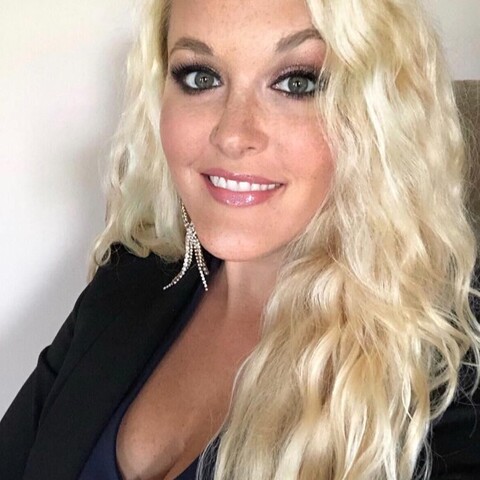
Katharine Kellar
Katharine is the Director of Marketing Communications at AVOXI, bringing over 17 years of experience in nurturing B2B, e-commerce, SaaS, and global brands. Fueled by her relentless drive for growth and an unwavering optimism, she finds joy in every day's silver linings. Outside of her professional achievements, Katharine is a coffee aficionado, savoring the aroma and taste of a freshly brewed cup as she crafts compelling narratives that resonate across diverse markets.
Web Application
SIP Integrations
Integrations
Programmable Voice
Our Leadership
Talk to an Expert
HIPAA Compliance | Privacy Policy | Política de Privacidad | PAIA AVOXI Manual | PAIA Forms | POPIA | U.S. Terms & Conditions | South Africa Terms & Conditions | Cookie Policy | Política de Cookies | Data Processing Addendum | AVOXI Patents
©2024 AVOXI
Sign Up for Our Newsletter
You'll receive a monthly newsletter where you'll discover new content at AVOXI, including events, product updates, and industry trends.
Can't finish the course?
We'd love to hear your feedback to improve your learning experience.
Existing Agents Login Here

Reset Password
The 8-Step Tourism Marketing Strategy (Free Template)
By Erick Tomaliwan
Share this article:
- Facebook icon
- LinkedIn icon
- Twitter icon

You should never leave your marketing up to chance.
Sure, it’s important to be nimble to changing conditions, such as tourism marketing trends , algorithm updates, employee churn, and evolving technology. But if you’re always throwing tactics at the wall to see what sticks, you’ll likely waste resources, fall behind your competitors, and miss out on future opportunities.
Instead, it’s far better to have a well-thought-out marketing strategy in place.
Trial and error can come afterwards.
What is a tourism marketing strategy?
A tourism marketing strategy is a structured document that outlines your current position in the marketplace, what you hope to achieve going forward, and how you’re going to make that happen.
In other words, it provides a framework, so you’re not floundering around, wondering what to do next. All while giving you a way to track your progress so that you can be confident you’re heading in the right direction. And if things change drastically, as we witnessed in 2020, you’ll always have a foundation to build off and make adjustments.
So, are you ready to come up with a master plan? We’ll cover what goes into marketing strategies for travel and tourism, which includes a:
- SWOT Analysis
- Value Proposition
- Guest Personas
- Competitor Profiles
- Marketing Mix
- Budget & Resources
- Goals, Metrics & Activities
- Marketing Roadmap
Follow along by downloading our free 8-Step Marketing Strategy Workbook.
How to write a tourism marketing plan, 1. run a swot analysis.
A SWOT analysis is a fun exercise that identifies your company’s S trengths, W eaknesses, O pportunities, and T hreats.
Strengths and Weaknesses are internal factors that you can control, like your team, resources, and location. In contrast, Opportunities and Threats are external factors that come and go randomly, leaving you with no other choice but to react and adapt — such as travel trends, economic downturns, and your competitor landscape.
To help you with this step, it’s a good idea to round up key members of your team across departments. Why? Because each representative will bring a unique perspective, allowing you to get outside of your business owner bubble. For instance, your tour guides know your guests the best and can offer insight into what they’re thinking and feeling.
Once you have everyone together — in the same room or Zoom meeting — you can start the process. First, answer a few questions that relate to each element.
Like for Strengths, you can ask, “what does our tour company do well?” and “what do guests like about our experiences?” Weaknesses, “what areas of the business need improvement?” and “what do our competitors do better?” As for Opportunities, “is there an underserved market we can tap into?” and Threats, “ are there new regulations that impact our business?”
Try to answer at least five questions each, and then summarize what you come up with in a 2×2 SWOT grid for a visual overview.

2. Identify your value proposition
After doing your SWOT Analysis, you should have a general idea of your value proposition — which is a simple statement that answers why someone should book with you instead of your competitors. Essentially, it’s what sets your travel business apart based on the desirable attributes you bring to the experience.
Your value prop is the most important piece in your marketing strategy, as it dictates your messaging and ultimately serves as the first thing guests look at when evaluating your brand with the “what’s in it for me?” mindset. That’s why it should be front and center on your homepage.
But it can be difficult narrowing down all of your unique qualities into one or two sentences. So, your best bet is to compile a list of features and benefits, along with the emotional value for each, and see if there are any obvious patterns.

Looking at the example above, you can see there’s a trend towards a local experience, so the value proposition for this company could be something along the lines of: Experience Hanalei Bay the local way with a paddleboard that looks nothing like a rental.
3. Create a guest persona
If you try to appeal to everyone, you’ll wind up appealing to no one. That’s probably one of the biggest tourism branding mistakes.
Instead, go after 20-35% of people most likely to enjoy your experiences. That way, you can be more effective with your targeting because you’ll understand what makes them tick, or better yet, what makes them book.
How do you go about doing that? Create a guest persona!
What’s a guest persona?
A guest persona is a detailed description of a fictional character that represents your ideal guest. It answers who they are, where they’re from, what matters to them, and where they hang out online.
Thinking of them as a real person before check-in will make it so much easier to craft personalized marketing messages they won’t be able to resist. Plus, you’ll know the best way to reach them. No more unanswered ads!
To create a guest persona:
- Start by combing through your booking data for common demographics like age, gender, geolocation, and language
- Refer to Facebook Audience Insights for psychographics, such as interests and hobbies, lifestyle, and online spending behaviour
- Send out a guest survey to get more details
Then, compile all of your information into a guest persona template with a stock image to put a face to the data. As well as a fun and fictional name — like Solo Travel Sarah , Corporate Catrina , or Vacation Dad Victor .

Now, you might only require one guest persona, but if you offer multiple experiences that appeal to different types of people, like tourism products for senior citizens , it’s best to segment your guests into a few personas seeing as your marketing tactics will change accordingly.
4. Create a competitor profile
The travel industry is tight-knit, so much so that you can even turn your competitors into partners. But that doesn’t mean you can’t still keep tabs on them.
Knowing what your rivals are doing is the best way to gain a competitive edge. Not only does it give you valuable insight into their strengths and weaknesses so that you can see how you stack up, but it also helps you stay one step ahead since you can spot potential threats and opportunities before they happen.
Similar to a guest persona, you can create a profile for your top three competitors, which should include the following marketing information:
- Their value proposition
- The experiences they offer and what they charge
- Who their target audience appears to be
- Unique features and benefits they highlight
- Overall rating on review sites, along with what their guests say about them
- The social media channels they dominate and the type of content they post
- What distribution channels they rely on
- Their domain authority score and top ranking keywords (use a tool like Moz Keyword Explorer to get this information)

It doesn’t stop there. After you’ve built your competitor profiles, you can monitor what they get up to in real-time by:
- Setting up Google Alerts to track mentions of them online
- Following their social media accounts
- And subscribing to their newsletter if they have one
You can always use a fake email address or Instagram account (AKA a Finsta) if you don’t want them to know you’re spying.
5. Develop a tourism marketing mix
A tourism marketing mix is a combination of factors you can control to influence a guest’s decision to book with you. Think of it as a broad guideline for how to market travel and tours so that everything works together seamlessly.
Historically, there are 7ps of tourism marketing, but since tourism operators are unique in the products and services they provide, we’ve stretched it to include eight.
What is a tourism marketing mix?
The experiences you offer and what’s included. Take note of everything that would go into the product description, such as duration, itinerary, special features, and other important details.
Where people can book your experiences. Traditionally, that would be your ticket office or travel agents, but there are now countless ways people can book — OTAs, email, chatbots, Facebook, your website. Figure out the number one place you want to direct prospects.
The price guests will pay based on the perceived value. Factor in what your competitors charge, how much it costs you to provide the experience, your revenue target, and where the market is heading.
4. Promotion
How you’re going to get the word out. Look at what has worked well in the past, where you already have some traction, new social media opportunities, and the best content format for your target audience.
The people who facilitate the experience. What are the standout qualities your staff has that align with your brand? What skills do your guides have that make the experience memorable, entertaining, and informative?
6. Planning
The measures you take to keep guests in the loop. How do you ensure they show up prepared? How do you tell them about your flexible cancellation policy? Are there any tactics you use to prevent refunds? What if you have to make unwanted changes?
7. Processes
The processes you have in place to guarantee guests get the experience they expect. Everything should run smoothly from the get-go. Consider ways to shorten check-in, stay on schedule, and make them feel valued.
The physical evidence that proves your guests had the best time. This could be in the form of professional photos or merchandise. But it can also be online reviews you encourage them to write on popular platforms.
6. Factor in budget and resources
Everyone wishes they could have marketing clout like the big-name online travel agencies. But the reality is you might never have the same budget and resources to run global campaigns. And that’s okay.
You don’t need deep pockets to make an impact. Thanks to the internet, you can use plenty of cheap marketing ideas to generate buzz around your brand. You just have to channel your creativity.
That said, be sensible with what you take on. For example, if you want to start a blog but don’t have time to commit to a regular publishing schedule, see whether someone on your team has the skills and bandwidth. If not, it isn’t in the cards for you right now.
So, check in with your budget for how much you can reasonably put towards various marketing activities while keeping in mind the software tools and staff you’ll need to execute successfully.

7. Pinpoint goals, metrics, and activities
Now that you know all that you know, give yourself something to work towards by determining what you want to achieve this year and how you’re going to make it happen. We suggest starting with the arbitrary number of four goals and key activities. Why?
Because if you chase too many rabbits at once, you won’t get the results you want. Instead, it’s better to prioritize goals that make sense for your business right now. That way, you can focus on doing a few things well, rather than lots of things badly that’ll only hurt your brand in the long run, which you’ll end up having to fix later anyway.
When it comes to setting marketing goals , it’s important to be SMART . Don’t just put your finger to the wind and say, “I think we should go this way.” Your goals should be:
- S pecific: clearly explains what you want to achieve
- M easurable: has a metric you can objectively measure
- A ttainable: something you have to stretch for, but still within your reach
- R ealistic: relevant to your business and where you want to go
- T ime-bound: when you want to accomplish the goal by
Here’s an example using the SMART method:
Increase organic website traffic 40% by the end of 2021 from getting 1000 visitors per month from Google.
How are you going to track your progress? As you can see in the above example, the number of website visitors is the primary metric. Now, many people will tell you to steer clear of vanity metrics — like traffic, followers, and shares — because they don’t directly impact your bottom line.
We couldn’t agree less. Marketing is about the long-game. While those metrics don’t always translate into transactions, they do strengthen brand equity, which in turn drives bookings over time because guests gravitate towards operators with extra oomph online.
The Content Marketing Institute puts it best : think of vanity metrics as optimization metrics. Instead of tying them to ROI, consider their overall value for better understanding your audience on specific channels.
For instance, if a particular social media post generates way more likes than average, it indicates something about that content resonates with your audience. You can pinpoint what that may be and replicate it in future posts or use it as a blueprint for creating effective Facebook ads .
For each goal you set, figure out one key activity that’ll help you hit it. Don’t be afraid to think big here. By that, I mean, come up with a significant marketing project that you and your team can chip away at — more on that in the next step.

8. Plan your marketing roadmap
After you’ve assigned an activity per goal, break each one down into smaller, manageable tasks to complete from quarter to quarter. Using the example above, let’s say you decide to start a blog as your key activity.
In Q1, you’d get the ball rolling with a few foundation tasks. So, for building a blog, you might start with the following:
- Set up the blog on your website
- Develop a content strategy
- Research topic and keyword opportunities
- Create an editorial calendar
Then, you’d build from there for Q2 and so on.

Try starting with four tasks per activity. Unless you have a marketing team, it’s best not to bog yourself down with a marketing plan that will either a) pull your team away from other responsibilities or b) feel so overwhelming that you abandon it altogether.
With a list of tasks, you can then organize everything onto a visual roadmap however you see fit — just so long as it includes a way to assign staff and track work progress. For instance, you can create a makeshift roadmap if you’re savvy with Google Sheets or use a project management tool like Trello and set-up a kanban board workflow.
Where to go from here?
It’s time to go after it, of course! Just remember that your marketing strategy isn’t set in stone since anything can happen to derail your plans — as we learned the hard way in 2020. So check in with your marketing strategy workbook from time to time to make any necessary adjustments.
Ready to write down your marketing strategy and make it real?

Take your business to the next level
Online bookings. Flexible pricing. Outstanding support.
Related Articles

How to write ATV tour descriptions that drive bookings (with examples)
Learn how to write ATV rental descriptions with SEO-ready language that help you sell more bookings
- Marketing Strategies

Easy & effective pricing tactics for activity and rental operators
Ever wondered why at the movie theatre you’re likely to opt for a Large Popcorn instead of a Small or…
Search Blog
Subscribe to our newsletter.
Get tips and strategies to grow your business and impress your guests.
Blog Categories
- Booking Management
- Business Tips
- Guest Experience
- Operator Highlights
What Are the 4 Ps of Marketing? The Marketing Mix Explained [Example]
Published: October 03, 2023
If you've been a marketing professional for years now, learning about the four Ps of marketing might seem like a throwback to you.

However, for those of us who work in the industry but didn't study marketing in college, it's entirely possible you haven't heard of the marketing mix.
Below, let's learn about the four Ps of marketing and how they're still relevant in today's marketing landscape.
![4 ps of tourism marketing → Free Resource: 4 Marketing Mix Templates [Access Now]](https://no-cache.hubspot.com/cta/default/53/c79f682e-61ec-4234-80b3-0b1f3833ee30.png)
What are the 4 Ps of marketing?
The four Ps of marketing are product, price, place, and promotion. These are the key factors that are involved in marketing a product or service. You take the four Ps into account when creating strategies for marketing, promoting, advertising, and positioning your product or brand.
The four Ps are meant to help marketers consider everything about a product or service when they're deciding how to market it for their business. Framing your marketing around the four Ps will help you learn what the competition is doing and what customers want from you.
.png?width=4000&height=2000&name=4%20Ps%20of%20Marketing%20(1).png)
How to Use the 4 Ps of Marketing
You can use the four Ps to answer questions about the product, price, place, and promotion of your product or service.
For example, you can ask yourself:
- Product : How does your product meet your customer's needs? What problem(s) does it solve? What unique value or features does it offer?
- Price : What is the value of your product? What are my competitors charging?
- Place : Where are customers looking for your product?
- Promotion : How can you differentiate your product from competitors? Where can you reach your audience?
Always consider the needs and preferences of your target audience. Ultimately, your product, its price, its place of distribution, and its promotional strategies should appeal to your customers the most.
Thinking about your marketing in terms of the four Ps will help you strategize how to reach your customers. The 4 Ps of Marketing are also known as your marketing mix — more on that below.
What is the marketing mix?
The marketing mix is also known as the four Ps of marketing. It refers to the four key elements of a marketing strategy: product, price, place, and promotion. These elements guide the marketing initiatives, wording, and positioning for a product or brand.
.png)
Free Marketing Mix Templates
Map out your marketing mix with these free templates
Download Free
All fields are required.
You're all set!
Click this link to access this resource at any time.
To develop a marketing mix, you'll need to think about how you can uniquely position your brand amongst the competition. The most important part of thinking about the marketing mix — or the four Ps of marketing — is to understand the customer, the competition, and your company. You'll evaluate your product and how to promote it.
But getting started isn’t easy. That’s why we’ve created the ultimate collection of marketing mix templates you can use to visualize your marketing mix and share it with your employees or investors. Use the templates to organize your initiatives and activities by the right section.
Featured Resource: Marketing Mix Templates

Click here to download the templates for free .
Use the template to follow along with the 4 Ps of marketing below.
The 4 Ps of Marketing (Example)
1. the first p of marketing: product.
When you think about your product, consider exactly what you're selling. Is it a specific product? Or is it a service? Your product can be a physical product, an online app, or a service such as house cleaning. Really, anything that you're selling is the product.
Then, think of your brand messaging, the services you offer, and even packaging. When you define your product, think about what problem your product solves for your customers. Consider how your product is different from competing products. What features are unique to your product?
It's important to know your product intimately so you can market it.
Product Example
We’ll use Marketing Hub as an example.
What is it? “Marketing automation software to help you attract the right audience, convert more visitors into customers, and run complete inbound marketing campaigns at scale — all on one powerful, easy-to-use platform.”
Who is it for? Modern marketers who juggle too much data and who are stuck with impossible-to-use software solutions that make their job harder, not easier.
Which features does it have? Marketing Hub offers blogging, SEO, social media management, email marketing, and ad tracking tools in a single, intuitive platform.
What problem does it solve? Marketing Hub simplifies the marketing automation process for busy marketers by bringing all data and tools under one roof.
2. The Second P of Marketing: Price
When it comes to price, you have to consider how much you're going to charge customers for your products or services. Of course, you need to make a profit.
When coming up with your pricing strategy , you also need to think about what competitors are charging for the same product or service and how much customers are willing to pay. You can also think about what discounts or offers you can use in your marketing.
When you decide on a price, you want to think about perception. Do you want to be known as a cost-effective option in your industry? Or perhaps you're a luxury brand and the price is slightly higher than competition on the market. Keep in mind that pricing SaaS products is a little different than pricing physical products.
Either way, the language you use to market your product will be greatly impacted by the price of your product.
Download a sales pricing calculator for free .
Price Example
Marketing Hub is priced to grow with you as you grow.
We offer the following subscription tiers:
- $0/month (Free)
- $45/month (Starter)
- $800/month (Professional)
- $3,200/month (Enterprise)
3. The Third P of Marketing: Place
When it comes to place, this might mean the physical location of your company, but it could also be defined as anywhere you sell your product, which might be online.
The place is where you market and distribute your product.
Remember that not every place makes sense for every product. For example, if your target market is seniors, then it won't make sense to market on TikTok. It's important to choose the right places to market your product and meet your customers where they're at.
Think about possible distribution channels and outlets you could use to sell your product. Be sure to take into account whether your business is B2B or B2C .
At this point, you'll need to think about how to market your product on all the various channels that make sense for your company.
Place Example
As a provider of a SaaS product, we offer Marketing Hub directly on our website.
Marketers can sign up for Marketing Hub by creating an account directly on our platform. We’ve created a convenient sign-up page for free subscriptions — or they can request a demo from our friendly sales team.
4. The Fourth P of Marketing: Promotion
Promotion is the bread and butter of marketing. This is when you'll think about how to publicize and advertise your product.
Additionally, you'll discuss brand messaging, brand awareness, and lead generation strategies .
When it comes to promotion, keeping communication in mind is of the utmost importance. What messages will resonate with your target market? How can you best promote your product to them?
Think about where, when, and how you'll promote your brand.
Promotion Example
We want to be where marketers are. Most importantly, we want to help them grow in their careers — as well as grow their businesses.
Our inbound marketing strategy will focus primarily on organic acquisition. We’ll promote Marketing Hub over the following channels:
- The HubSpot Marketing Blog
- HubSpot Academy
The 4 Ps of Marketing Examples: Apple and e.l.f. Cosmetics
Let's break down the 4 Ps of marketing for Apple and e.l.f. Cosmetics.

( Image Source )
- Product: iPhones, Macs, iPads, Apple Watch, AirPods, Software, and Services (i.e., Apple Music, Apple TV, iTunes, etc.).
- Price: Apple products are often priced at the higher end of the market. The brand commands premium pricing due to its reputation for innovation, quality, and design.
- Place: Consumers can purchase products online and in retail stores. Apple products are sold worldwide and have a significant global market presence.
- Promotion: Apple places a strong emphasis on cultivating a dedicated and loyal consumer base. Their marketing campaigns reinforce the idea of being part of an "Apple ecosystem." Once users buy one product — like an iPhone – they're more likely to choose other Apple products like MacBooks, iPads, Apple Watches, and more. This ecosystem fosters a deep brand loyalty. This sense of loyalty is evident in their product launches, which are a must-see event in the tech industry.
e.l.f. Cosmetics

- Product: e.l.f. offers a comprehensive range of makeup and skincare products, brushes, and beauty tools.
- Price: One of e.l.f.'s main value propositions is its affordability. Many of their products have a low price point, making the brand accessible to a wide range of consumers. Its lower price point sets it apart from other brands in the beauty space.
- Place: e.l.f. products are widely available in drugstores and big-box retailers like Target and Walmart. It also has a a strong online presence, selling products directly through their website and other online retailers.
- Promotion: As a challenger brand in the beauty space, e.l.f. seeks to establish itself as a recognizable and reliable option at the drugstore and beyond. The brand is proactive across social media, including TikTok, Instagram, and YouTube, to engage with younger demographics. In addition, their campaigns often involve user-generated content to foster a sense of community with their audience.
Back to You
Even though marketing has changed since the four Ps were developed, the foundational elements of the industry haven't. You can apply the concepts of the marketing mix to create winning marketing strategies that help you profitably launch and promote your company’s products.
Editor's note: This post was originally published in October 2020 and has been updated for comprehensiveness.

Don't forget to share this post!
Related articles.

The 2024 State of Marketing & Trends Report: Data from 1400+ Global Marketers

Mastering Social Media for Nonprofit Promotion: Insights and New Data from Experts

The AIDA Model: A Proven Framework for Converting Strangers Into Customers

Demystifying Marketing's 6 Biggest Mixed Messages of 2024 with Jasper's Head of Enterprise Marketing

The Ultimate Guide to Marketing Strategies & How to Improve Your Digital Presence


9 Pivotal Marketing Trends to Watch in 2024, According to Experts

Diving Deep Into Marketing in Construction (My Takeaways)
![4 ps of tourism marketing 11 Recommendations for Marketers in 2024 [New Data]](https://www.hubspot.com/hubfs/Marketing%20Recommendations.png)
11 Recommendations for Marketers in 2024 [New Data]
![4 ps of tourism marketing The Top 5 B2C Marketing Trends of 2024 [New HubSpot Blog Data + Expert Insights]](https://www.hubspot.com/hubfs/top%20b2c%20marketing%20trends.png)
The Top 5 B2C Marketing Trends of 2024 [New HubSpot Blog Data + Expert Insights]
![4 ps of tourism marketing 5 Marketing Trends That Might Not Survive in 2024 [HubSpot Research + Expert Insights]](https://www.hubspot.com/hubfs/marketing%20trends%20that%20might%20not%20survive%202024.png)
5 Marketing Trends That Might Not Survive in 2024 [HubSpot Research + Expert Insights]
Organize your product, price, place, and promotion initiatives in a simple, single template.
Marketing software that helps you drive revenue, save time and resources, and measure and optimize your investments — all on one easy-to-use platform
- The 4 P’s of Marketing in Relation to The Tourism Industry

What Are The 4 P’s of Marketing in the Tourism Industry?
The hospitality and tourism industry thrives on the allure of unforgettable experiences. The essence of effective marketing in this sector hinges on the 4 P’s - Product, Price, Place, and Promotion. These pillars are instrumental in crafting a compelling marketing strategy that resonates with the target audience and propels business growth.
The 4 P’s of Marketing: Bridging Tourism and Marketing Fundamentals
Product: Crafting Unforgettable Experiences
The tourism sector is unique; the product is the experience. It could be the tranquil retreat to a beach resort, the thrill of a safari adventure, or the opulence of a five-star hotel. Understanding and enhancing the services offered is crucial in meeting and exceeding customer expectations. It's about creating memories that last a lifetime, which, in turn, cultivates customer loyalty and encourages repeat business.
Price: Balancing Affordability and Profitability
Pricing isn’t just about covering costs and ensuring a profit margin; it’s critical to communicating the service's value proposition. Employing competitive pricing strategies while providing exceptional service can foster customer loyalty and drive profitability. Moreover, pricing strategies should be flexible to cater to a broader range of clientele, thus expanding the market reach.
Place: Navigating Physical and Digital Interactions
The place is where customers interact with the service. In today’s digital era, an online presence is indispensable. An intuitive, well-designed website can significantly impact how potential customers perceive the ‘place’ where the service is offered. Moreover, integrating platforms like FareHarbor can streamline the booking process, enhancing the overall customer experience.
Promotion: Amplifying Visibility and Engagement
Promotion encompasses how businesses reach out to and engage with potential customers. Digital advertising and effective SEO (Search Engine Optimization) are crucial in enhancing online visibility and attracting a larger audience. Tracking conversions, for instance, can provide invaluable insights into the effectiveness of advertising campaigns.

Marketing Strategies in Tourism
Incorporating the 4 P’s into marketing campaigns is essential for creating resonant and effective tourism marketing strategies . Each of the 4 P’s plays a crucial role in communicating the value and uniqueness of the offered tourism experience.
Product Strategy: Tailoring Unique Experiences
A well-thought-out product strategy is the cornerstone of tourism marketing . It involves understanding the desires and expectations of the target market and tailoring the tourism product to meet and exceed these expectations. It's about creating a unique and memorable experience that distinguishes the service from competitors. This could offer unique local experiences, luxurious accommodations, or exciting adventure activities.
Pricing Strategy: Mastering the Dynamic Pricing Game
Pricing strategies in tourism need to be competitive yet profitable. They should reflect the value and quality of the experience offered. Dynamic pricing, which allows for price adjustments based on demand, season, and other factors, is a common practice in the tourism industry. It helps maximize revenue during peak seasons and ensure affordability during off-peak times, thus attracting a broader range of clientele.
Place Strategy: Streamlining Access and Purchases
The 'Place' in tourism marketing refers to the channels customers can access and purchase the tourism product. This includes both physical and online channels. An effective online presence, facilitated by an intuitive, user-friendly website and seamless booking processes through FareHarbor integrations , is crucial in today's digital era. It's about making the booking process smooth to enhance the customer experience.
Promotional Strategy: Harnessing Digital Outreach
Promotion is about creating awareness and generating interest in the tourism product. Effective promotional strategies encompass a mix of digital advertising, social media marketing, SEO, and content marketing. Tracking Google AdWords conversions , for instance, can provide invaluable insights into the effectiveness of digital advertising campaigns, enabling data-driven decision-making to optimize advertising spend. Leveraging the expertise of a tourism marketing agency can provide a significant advantage. Such agencies bring in-depth knowledge of the tourism market, digital marketing expertise, and the resources necessary to design and implement comprehensive marketing strategies. They can help craft compelling narratives that resonate with the target audience, optimize online advertising campaigns, and ensure a robust online presence through SEO and web design.
Return on Investment: Measuring Your Performance
Analyzing the performance of marketing strategies through metrics such as website traffic, conversion rates, and customer reviews is crucial for continuous improvement. It provides the insights necessary to refine marketing strategies, making them more effective over time. Effective marketing strategies in tourism are about creating a compelling value proposition, reaching the right audience through the right channels, and continuously optimizing based on performance insights. It's a holistic approach that requires a blend of market understanding, digital marketing expertise, and continuous analysis and refinement to succeed in the competitive tourism market.

The Role of Digital Advertising in Tourism
Digital advertising extends the reach of your business to a broader audience. It’s a conduit to showcase the unique experiences your service offers. Measuring the success of advertising campaigns is pivotal in understanding the ROI and optimizing future campaigns. Tracking conversions is a practical approach to measuring advertising campaigns' effectiveness and optimizing advertising spend.
Web Design and SEO for the Hospitality Industry
An appealing online presence is a requisite in today’s market. Professional web design and SEO optimization attract more visitors and convert leads into customers. Moreover, SEO for the hospitality industry ensures that your website ranks high on search engine results pages, making it easier for potential customers to find you.
Final Thoughts
The 4 P’s of Marketing are the linchpin in crafting a successful marketing strategy in the hospitality and tourism industry. Employing effective marketing strategies, embracing digital advertising, and optimizing web design and SEO are pivotal steps toward achieving business success in this competitive industry. Partnering with a tourism marketing agency that understands the intricacies of FareHarbor WordPress Integrations and the broader digital landscape can significantly enhance your marketing efforts, ensuring a robust online presence and a steady stream of satisfied customers.
Popular Post
- Unlock the Full Potential of FareHarbor: Funnel Performance Calculator
- Understanding the FareHarbor Ecosystem: Tips and Tricks for New Users
- How to Track Google AdWords Conversions from FareHarbor Reservations
The Top 5 Tourism Marketing Strategies for Your Business
Similar blogs.

The Top Tourism Marketing Strategies for Your Business
In the bustling realm of the tourism...

What is Tourism Marketing?
What is tourism marketing and how can it benefit my business.
Tourism marketing is a specialized...

Navigating the Challenges of Seasonal Tourism: Strategies for Off-Peak Success
How to overcome seasonal tourism challenges with marketing.
Seasonal fluctuations are a reality in...
- English English
- தமிழ் தமிழ்
- বাংলা বাংলা
- മലയാളം മലയാളം
- ગુજરાતી ગુજરાતી
- हिंदी हिंदी
- मराठी मराठी
- Business Business
- बिज़नेस बिज़नेस
- Insurance Insurance
The Financial Express
- Mutual Funds
- Budget 2024 Date Live
- Share Market Live
- Weather Update
- Kuwait fire tragedy
- Loksabha Election
- Budget 2024
- Stock Market Quotes
- Mutual Fund
- Stock Stats
- Top Gainers
- CaFE Invest
- Investing Abroad
- Gold Rate in India
- Silver Rate in India
- Petrol Rate in India
- Diesel Rate in India
- Express Mobility
- Banking & Finance
- Travel & Tourism
- Brand Wagon
- Entertainment
- Web Stories
- Auto Web Stories
- Infographics
- Today’s Paper
- International
- Edits & Columns
- Personal Finance Print
- PRIVACY POLICY
- TERMS AND CONDITIONS

The four Ps of the tourism industry
The four ps of tourism—product, price, place and promotion—can be developed in myriad ways.

By Vidya Hattangadi
One of my PhD students had chosen the topic titled ‘ Marketing Strategies for Tourism Industry in Maharashtra’. She gave workable strategies in which corporates can donate towards CSR for maintenance and repair of Chhatrapati Shivaji’s forts and heritage structures in Maharashtra. The companies that she collected responses from were ready to donate for the heritage of Maharashtra, but required correspondence from the Maharashtra Tourism Development Corporation (MTDC) stating their plan of action and timeline for implementation. It’s past seven years; the MTDC has not worked on the proposal.

The reason for this article is that MTDC and all companies wanted to know the four Ps of tourism in detail. How do we explain the four Ps of tourism? Is tourism tangible or intangible creation? The most accepted definition is provided by the UN World Tourism Organization (UNWTO): “Tourism comprises the activities of persons travelling to another place outside their usual environment for not more than one consecutive year for leisure, business and other purposes.”

In humans, there is a natural curiosity to know different places, the culture, and the desire to travel is inborn. People keep travelling for a number of reasons. Travelling activities will never stop; so, tourism activities will increase in the future more and more, especially with the development of transportation systems and information technology . Nevertheless, tourism is a multifaceted industry that involves numerous stakeholders, right from the government of a nation, hospitality stakeholders, and the natural environmental factors themselves—each contributing to either for growth or downfall.
Let’s understand the four Ps of tourism.
Product: This is the first element of the marketing mix. Tourism as a product differs from other products due to its large canvas. It covers a range of elements such as accommodation, food and beverages, transportation, scenic beauty, historical importance of the place, geographical state, and spiritual appeal. The fact is a destination gains importance from a customer’s perspective. Not everything is tangible in it; it is a mix of tangible and intangible elements. The destination is ‘product’ in tourism. From a marketing mix point of view, since tourism business is all about the experience of the ‘tourist’, it requires to be handled differently. I personally feel, as a traveller, that as a product each destination is complex in nature. Its packaging matters.
Price: In tourism, price is the amount of money a customer pays for a package. Whether the package is highly priced, properly priced or is low priced is decided by the experience of the tourist. The pricing should be based on the offering made, the accommodation standard, food standard, transportation standard, recreation and the aspirations to be met with. Some destinations are expensively priced while others are modestly priced. Tourism products are rarely identical. This is because locations differ and also because of the people and the components that make up the experience provided to a traveller. We see very diverse pricing strategies. For most tourism businesses setting prices are market -based. It is driven by what competitors with similar products and services charge within a given market. Let me clarify, in tourism, price competitiveness is not price-driven, it is product-driven. It also depends on seasonality element because tourism business is seasonal in nature.
Place: In tourism, distribution aspect is tricky. The link between tourism suppliers and the customers is known as the distribution system. In terms of definition, distribution is concerned with making the product available to the customer. It includes various activities undertaken to make the product accessible and available to target customers. Tourism being a service product—and here the customers need to be transported to various destinations (point of sale)—its channels are tourist operators, agents, wholesalers and ITOs (inbound tour operators). For the distribution channels in tourism, understanding the distribution systems, recommended rates of commission, and the roles of various booking agents matter.
Retailers provide customers with an accessible destinations; either online or as a shop-front by booking travel products. They sell products to customers. Wholesalers are businesses that will sell product through established retail distribution channels both at the shop-front and online on the behalf of the service provider. They also sell individual product elements and link them to shape packages. The role of the intermediary has been an important element at all stages experienced by the tourism sector. Technology has played a pivotal role in the growth of the travel industry.
Promotion: In tourism, it refers to informing the customers about the existence of a destination, staying arrangements, pricing, facilities provided, entertainment factors, etc. The promotional activity consists of educating, persuading and reminding the customers about the product. A variety of media vehicles are available and being used by the tourism industry. Meetings, Incentives, Conferences/Conventions and Exhibitions (MICE) are a form of tourism.
The capital city of India , New Delhi, has been a favourite MICE destination for quite some time. The numerous charms of the city vary from ancient monuments to excellent shopping options, making the business meetings and conferences here an absolute pleasure. The Ashok, New Delhi, has been hosting meetings and conventions on the international scale for more than four decades. Spread over 16,435 sq-ft, the pillar-less Convention Hall at The Ashok is a favourite venue for top businessmen and government officials. Other business meeting venues of the capital are the Habitat World Convention Centre and the Vigyan Bhawan.
The tourism business will turn more hypercompetitive post the pandemic. Tourist businesses will require adaptable and workable marketing strategies. The world is well-connected today. In true sense, sky is the limit for the growth of the tourism sector. The four Ps can be developed manifold and can be mixed and merged beyond imagination.
The author is a management thinker and blogger
Get live Share Market updates, Stock Market Quotes , and the latest India News … Read More and business news on Financial Express. Download the Financial Express App for the latest finance news.
- Stock Market Stats
Related News
Indian Railways will begin trials of Vande Bharat sleeper trains in 2 months, with operations starting in 6 months. These trains will have better features than Rajdhani Express and the government aims to have 250 by 2029. The railway minister mentioned the financial struggles due to subsidizing tickets and the withdrawal of concessions for senior citizens during the pandemic.
Photo Gallery
9 Productive discussions with world leaders! PM Modi at G7 Summit – PHOTOS
6 Top 6 World’s most expensive cars cost over Rs 300 crores combined: Cars for the planet’s richest
9 Rs 50, Rs 200, Rs 500 and Rs 2000 notes images: Here are the new currency notes released by RBI
Latest News

Odisha ministers’ portfolios: CM Majhi keeps home and finance, Deputy CM KV Singh Deo gets agriculture – Full list here

Foreign investors to focus on global trends and trading activity as market remains closed on Eid, say analysts

Canada announces the launch of a new permanent pilot caregiver program

Is India back on shopping list? FPIs invest Rs 11,730 crore in Indian markets last week

Five of top-10 firms’ Mcap increases by Rs 85,582.21 crore; LIC emerges as biggest gainer
Trending topics.
- IPO’s Open and Upcoming 10
- Top Indices Performance
- Stock Analysis
- Financial Literacy
- Gold Rate Today
- NSE Top Gainers 1537
- NSE Top Losers 1037
- BSE Top Gainers 2415
- BSE Top Losers 1716
- NSE 52-Week High 0
- NSE 52-Week Low 0
- BSE 52-Week High 0
- BSE 52-Week Low 0
- NSE Price Shocker
- NSE Volume Shocker
- BSE Price Shocker
- BSE Volume Shocker
- NSE Sellers
- BSE Sellers
- Silver Rate Today
- Petrol Rate Today
- Diesel Rate Today
7P’s in the tourism marketing mix for tour & activity providers

By Rezdy — 5 Aug 2018
Direct Marketing marketing tourism business strategy
Updated November 2021 – Anyone who runs a business or markets a specific product within the tourism industry knows about the tourism marketing mix . The traditional marketing mix was created in 1960 and has been applied to nearly every product created since then. The marketing mix contains the 4 P’s: product, place, price, and promotion. However, 3 extra P’s apply for the experiences industry: People, Processes, and Physical Evidence. As a tour operator, here’s what you need to know about the basic tourism marketing mix and how you can utilize them to analyze your competitive strategies.
The Traditional Marketing Mix
Product is the first step of the marketing process because you need to create a product that consumers want. Without the right products, it won’t be easy to market your business and attract customers to your services.
As a tour and activity provider, you must offer a specific tour or activity that is in demand. It should be a high-quality tour and an authentic experience . By striving to exceed your customers’ expectations, you will surely gain a target market that seeks your product.
Decades ago, tour and activity providers simply sold their products through their storefront and through travel agents. Today and with the advancement of technology , you have to make sure your tours and activities are available both online and offline. This allows for a wider avenue of bookings to come through from a wide variety of platforms.
These days, most travelers want to book online in order to make their reservations, and it’s essential to have a mobile-friendly website that accepts bookings. By being able to be bookable anywhere your customers are, it eases the overall booking process. Ultimately, this increases your chances of capturing their bookings.
Price your tours and activities according to demand and value is essential. You don’t need to give away your products for free in order to attract customers. You simply need to offer them a valuable experience that they find worthwhile.
By marketing your products correctly and providing evidence that your tours and activities are credible, you can align your services with a price point that customers will agree to pay.
You should utilize a variety of advertising techniques and marketing campaigns to promote your business. Whether that be an online promotion or an exclusive offer between your business and an agent, promoting campaigns correctly is key to boosting your sales.
How and where you communicate your campaigns is also an important element to your promotion’s success. Utilizing channels such as your website, social media, storefronts, and agents (including OTAs) will help widen your business’ exposure.
By strategizing and communicating your campaigns correctly, it increases your chances of being discovered and will boost your sales.
The tourism marketing mix: 3 extra P’s
Tour and activity providers should note that there is an extension to the marketing mix that should be applied to their own unique services. The service marketing mix, or in our case, the tourism marketing mix consists of 3 more P’s, and was developed in 1981., It applies to every business that sells services and, experiences as a product.
When it comes to marketing your tour and activity business, here are a few “take-aways” about the extended tourism marketing mix and how it will help your business.
Invest in the right employees who demonstrate the qualities of a good tour guide . Your staff and guides are the faces of your company. They will represent your business and are one of the main determining factors of your customer’s satisfaction. By hiring enthusiastic and entertaining guides, it can help draw more customers to your business and will enhance the overall customer experience.
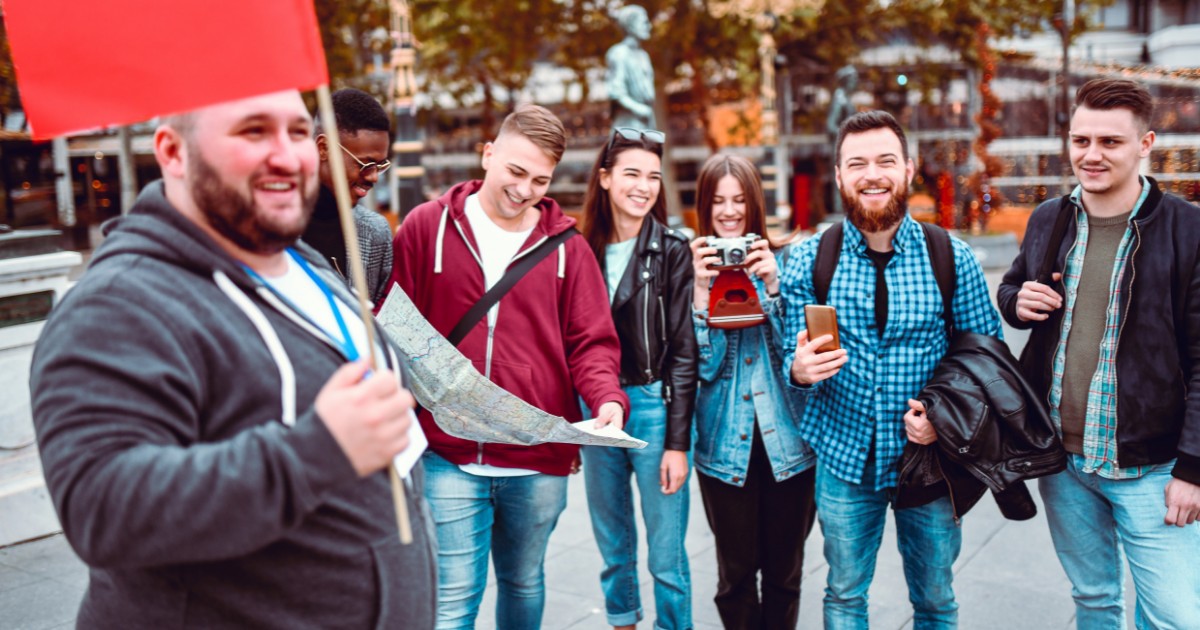
Your processes are key to a great customer experience . Clear processes provide convenience for both your staff and your customers. It ensures your business’s operation and procedures run smoothly.
By having an online booking software like Rezdy, managing your processes will become an automatic process. A software like Rezdy allows customers to book based on real-time availability and will automatically adjust your manifests. This will ensure that everyone involved will be aware of upcoming bookings and can prepare resources accordingly.
The proper processes will make sure your tours run on schedule and avoid any hiccups such as overbooking and long waiting times. This will help give your customers the experience they’ve been promised and will encourage them to re-book and promote your business.
Physical Evidence
Give your customers physical evidence of what they paid for when they booked their tours. Make sure vehicles, gears and other materials are clean and presentable. Your staff should also be trained and properly presented, and if you have a storefront, make sure it’s well-maintained.
Physical evidence is effectively part of your tour branding strategy , so by providing physical evidence that your business is up to standards, will encourage customers to leave a positive review for others to see.
One way to execute the 7 P’s of the tourism marketing mix is by investing in an online booking software built specifically for your business. A software like Rezdy will help improve your processes by giving you a detailed insight into your business. This will allow you to set your best prices, promote in the correct place and engage with the right people. Curious to see if Rezdy is right for you? Sign- up for a FREE 21-day trial or request a demo today.
If you enjoyed this article then make sure to follow the Rezdy blog . There are a lot of marketing tools and tour operator tips designed with businesses like yours in mind.
Start free trial
Enjoy 21 days to take a look around and see if we are a good fit for your business.
No obligations, no catches, no limits, nada
Marketing91
What is Tourism Marketing? 15 Strategies in 2023
March 22, 2023 | By Hitesh Bhasin | Filed Under: Marketing
From hotels and other types of accommodation to car rental services, airlines , restaurants, entertainment spots, and travel agents – tourism marketing encompasses a wide range of advertising and marketing strategies often used by companies in the tourism and travel industry themselves. All these various marketing efforts are put together under one collective name – Tourism Marketing!
Tourism marketing is an essential tool for a business to ensure they are standing apart from its competitors, garnering customers, and creating brand recognition. Nowadays, various digital marketing platforms such as websites, online ads, email marketing campaigns , and social media marketing outlets have become vital components of modern tourism marketing initiatives for businesses.
Table of Contents
What is Tourism Marketing?
Tourism marketing is a type of marketing used by businesses operating in the travel and tourism industry to attract tourists to a business name or particular location which can be a state, a city, a particular heritage site or tourist destination spot, a hotel, or a convention center anything.
Achieving success in the travel and tourism industry requires thoughtful Tourism Marketing campaigns that are designed to generate brand awareness , create both, reach the most target audience or potential customers, drive traffic, foster loyalty among existing clients, and create a captivating customer experience . By utilizing these strategies, businesses can effectively engage with travelers while generating more sales opportunities.
Tourism Marketing has been profoundly impacted in recent years by digital development, as well as changes in consumer attitudes and desires. Crafting successful Tourism marketing messages today entails taking advantage of social media platforms, featuring user generated content, leveraging online reviews and search engines to your benefit, collaborating with influencers to drive traffic and expand reach, and experimenting with various channels for targeted messaging to attract travelers and optimize their customer journey in a way to convert them into loyal customers.
Why is Tourism Marketing Important?
To make a tourism business thrive, savvy marketing is an absolute must. By staying up-to-date with current trends and launching impactful campaigns, businesses can boost the recognition of their brand, gain customer loyalty and attract travellers. Moreover, tourism marketing holds promise for contributing to the economic growth of the region by driving tourists towards local enterprises.
The tourism industry is one of the biggest in the world and therefore highly competitive. To succeed, businesses must differentiate themselves from their competitors by promoting and advertising what makes them unique, showcasing why they’re the best option for tourists, and advertising and highlighting any special features that set them apart.
To allow businesses to gain a competitive advantage , marketing is essential. Many of the top tourism marketing approaches concentrate on highlighting a business’ unique selling point and broadcasting it effectively. Moreover, marketers must keep abreast with current trends to generate an effective promotional mix and deploy the most viable methods for disseminating their message across all channels.
Understanding the concept of Tourism Marketing
Tourism marketing is associated with most businesses, with marketing strategies in the field of tourism. Today there are many countries in the world, where the tourism industry plays a major role in economic development , enhancing their GDP.
In such cases, tourism and digital marketing become important things. Many of the places are generally the hotspot for tourists like the Taj Mahal in India. Now places like these are considered the perfect areas where one can boost tourism through digital marketing.
The places which are more likely to be the major spots for attracting tourists are the places where tourism marketing flourishes the most. Now tourism marketing is all about applying several marketing techniques and strategies to create and boost the tourism industry of that place.
For successful tourism marketing to take place, the thing that is required the most is that the brands should speak for themselves in such a way that makes sense that their voices can be heard in the targeted markets. This way they will be able to generate the cleanest successfully. Also, they need to be really careful in providing services to clients.
This is because if the customers are happy with the services chances they will spread the word and this may bring them more customers. In the case of tourism marketing, it becomes easy to find the right audiences and create content to draw the attention of the targeted customers to the website by providing encouraging content. Thus strategic planning , content marketing, and branding is the key to effective tourism marketing.
With it being carried out by keeping these two points in mind, chances are that the company that is involved in tourism marketing will be able to gain the advantage over their existing customers in no time and become a monopoly in the tourism industry.
What are the different ways in which Tourism Marketing Can Be Done in 2023?
Now various methods are applied for tourism marketing to flourish. Below are some of the important ways in which the tourism marking of any place is given a boost.
1) Location marketing
In this type of marketing strategy , the main focus of tourism marketing is one bringing people’s attention to a specific location. In this strategy , no recommendations are made with respect to a particular site or any accommodation. Now some locations are already so popular all over the world that tourism marketers don’t have to make many efforts to attract their attention to such places.
All they need to do to attract customers is remind them of such locations and chances are that the consumer can easily get convinced to spend money and visit any such place. For example, Las Vegas is popular for its undying charm and full of life kind of prospects.
Now there s also a popular slogan related to Las Vegas which is ‘What happens in Vegas, stays in Vegas’. This slogan has gained worldwide popularity and almost everyone wants to visit Las Vegas at least once.
So here the tourism marketers have to simply remind people of how amazing this city is and what are the different ways in which they can have the time of their lives here. Another example that can be taken in Florida.
They use a more ‘benefit-oriented’ approach. Their slogan and website are ‘The Sunshine State’. This way they are presenting their state with a joyous and charming climate and as a perfect place for beach and football lovers. Also with their slogan and website, they are successfully able to present their state as an ideal ‘summer vacation’ destination and are definitely a dream for many to visit this place.
Thus location marketing is one of the simplest forms of tourism marketing in which without even putting much effort, with the brand value and the popularity of some specific location, the customers can be attracted.
2) Activity marketing
Now, this type of tourism is carried out keeping in mind both the location and the activities that are performed in such places. This type of tourism marketing strategy usually keeps in mind travelers who are adventure lovers or activity freaks.
There are many other sites and locations all over the world that are famous for some specific activities. Like Alaska is famous for snowboarding, Yellowstone national park is famous for thrilling activities like hiking, and camping and is a perfect place for all nature lovers, similarly, there is ‘Colonial Williamsburg’ which attracts all history lovers.
Thus depending on the target audience and the type of activity that a particular place is famous for, tourism marketing can be carried out. Some people may be adventure lovers, some people may be looking for art and culture some people love hunting, depending upon their area of expertise and interest, the tourism markers can segment the groups of potential visitors and customers and approach them.
Thus activity marketing is a form of tourism making and social media marketing that emphasizes the booking process and bringing the attention of a customer to particular places on the basis of the activities that are performed there.
3) Corporate marketing
This is quite an interesting approach to tourism marketing. Now it has been found that a large number of people working in corporate sectors have to travel to different places to attend a conference or a meeting.
Then according to research, it was found these locations were ideal for tourists, and a number of people came to attend those places. Also, they brought their families and their loved ones as well. Now considering these scenarios’ latest trends in mind, corporate influencer marketing can contribute a lot to tourism marketing as it has significant potential.
Here the tourism marketers take advantage of the fact that by planning the business meeting in touristy places, people come in large numbers thus they can make a lot of profit out of it.
What are the four basic pillars of Tourism Marketing?
The foundation of tourism marketing stands firmly on four of its important pillars which are the product , the price, the place, email marketing, and the promotion.
Let us understand each of these separately as to how they contribute to tourism marketing!
Marketing Mix of Tourism
1) product in tourism marketing.
One of the most important aspects of the tourism marketing strategy is to determine the effect of the selling benefits and the other types of benefits that are re-obtained by competing with their rivals in the same market .
Tourism marketers need to focus more on such destinations that provide both business advantages to travel brands and pleasure to their customers. These pleasures depend on several factors like the ease of traveling, facilities of the sites and the hotels, the nightlife of that place, activities offered, and the overall culture of that place.
Thus by considering these factors, tourism marketers will understand the areas that have to focus more on, so that marketing can be done effectively.
2) Price in Tourism Marketing
The price point is yet another important aspect of tourism marketing. Now many people avoid traveling due to money-related issues. And this is where tourism marketing comes in to save the day. Today so many mobile apps have been developed, on which if a person books a hotel r a transport like a flight or a train, they get discounts. This attracts a lot of customers.
Along with the free referral marketing, they also try to give value-added services to their customers. Some hotels also offer free shuttle services to their visitors. Also depending on whether it is a high season or an offseason, the prices are altered.
3) Place in Tourism Marketing
Now for tourism marketing to earn a profit, deciding the location where they want to perform the marketing can play a key role in how far they can go. The place refers to the area where the products and services can be distributed.
Now in tourism and destination marketing, the location and the destination marketers offer their products and services to their customers through travel agents, tour operators, inside sales teas, etc. The distribution of their products and services to visitors can be done through catalogs, online, sites, mobile devices, websites, stores, etc.
4) Promotion
In this numerous different strategies and technologies are used for the promotion of any specific area or tourist destination. In fact, trade magazines and meeting planners are also efficient ways for promotion purposes.
These often come with many other forms of discount coupons, brochures, etc. also they try their target customers to come across the ads that pop up on the website to make them aware of the various tourist places.
15 Tourism Marketing Strategies in 2023
1. prioritising hygiene and safety via marketing communication.
Tourism marketers must now prioritize safety and hygiene to give their customers peace of mind when they travel. By highlighting the protocols that are being taken, tourists can rest assured knowing they will be protected while visiting.
2. Developing Loyalty Programmes
Loyalty programs are the ideal way to demonstrate your appreciation for existing customers and stimulate repeated patronage. Tourism marketers should construct loyalty programs that will not only retain existing customers but also appeal to fresh audiences.
3. Capitalising on Voice Search
In the age of voice search, it is essential for tourism marketers to create content that can be quickly found and accessed. Optimizing your site and content for this new technology will bolster your site for visibility and success in the long term.
4. Facilitating User-Generated Content
User-generated content, such as ratings and reviews on social media, is critical in helping customers make informed decisions. User-generated social media content is one of the key tourism marketing trends.
5. Deploying Artificial Intelligence:
AI technology is a valuable asset for Tourism marketers, allowing them to track customer behavior and create personalized brand experiences tailored to each individual. This can help customers find the brand information they need quicker and more easily than ever before.
6. Not Neglect Review Marketing
Reviews and ratings are a critical resource for Tourism companies, making them an invaluable asset in swaying potential customer decisions. Any Tourism marketer must recognize the importance of reviews if they wish to stay competitive.
7. Enhancing the Guest Experience & Satisfaction Through Chatbots
Chatbots can be a vital tool in creating an effortless, tailored experience for all customers. Chatbot technology should be a top priority for the hospitality and tourism industry to provide quick customer service and support, as well as respond promptly to any inquiries.
8. Investing in Remarketing Efforts
Maximizing your Tourism business’ potential by tapping into already engaged customers is a surefire way of increasing sales. Leverage the power of remarketing to maximize your potential and gain more qualified leads.
9. Utilising Augmented Reality Technology
Augmented reality provides the ideal platform for tourism businesses to build mesmerizing and unforgettable experiences for their customers.
10. Prioritising Personalisation
Customization is a crucial element of this form of marketing. By personalizing content and messages to the target audience’s wants and needs, Tourism marketers can engineer and create an experience that will ensure positive word-of-mouth publicity for their business or brand.
11. Exploring Metaverse
The metaverse is becoming more and more popular with tourism companies, as it allows them to give their customers an unparalleled, immersive experience.
12. Using NFTs
Non-fungible tokens, or NFTs, are quickly becoming a widely recognized trend. Tourism companies can harness this technology to propel their marketing campaigns and draw in more visitors.
13. Promoting Virtual Reality (VR) Tours
Allow your customers to explore new destinations without even having to leave their homes – with VR tours, the possibilities are endless!
14. Focusing on the Customer Experience
Crafting an exceptional customer experience should be the primary focus of any Tourism promotional strategy . Optimizing customer experiences on all marketing channels is crucial.
15. Embracing content and influencer marketing
Content and influencer marketing are essential building blocks of any successful tourism strategy. It helps in optimizing the presence of a travel business in the search engine.
Thus, tourism and travel agency marketing are one of the branches of marketing that deal with the tourism and travel industry only.
It is essential to carry out efficient tourism marketing, as one can make a lot of money through this because there are so many people in this world who love traveling, and this can help the tourism marketing industry to flourish their business.
Liked this post? Check out the complete series on Marketing
Related posts:
- 15 Promotional Strategies to Use in 2023 (Types, Steps & Role in Marketing)
- What is B2B Marketing? A Comprehensive Guide with Strategies, Examples & Trends in 2024
- Database Marketing – Definition, Types, Importance and Strategies
- One-to-one marketing: Definition, Examples and Strategies
- What Is Affinity Marketing? Definition and Strategies for Success (Updated 2024)
- What is Consumer Marketing? Definition, Strategies & Example
- What is Offline Marketing? Strategies and Advantages
- Trade Marketing: Definition, Strategies, Advantages, Disadvantages
- Luxury Brand Marketing – Concept and Strategies
- Healthcare Marketing – Definition, Strategies and Challenges
About Hitesh Bhasin
Hitesh Bhasin is the CEO of Marketing91 and has over a decade of experience in the marketing field. He is an accomplished author of thousands of insightful articles, including in-depth analyses of brands and companies. Holding an MBA in Marketing, Hitesh manages several offline ventures, where he applies all the concepts of Marketing that he writes about.
All Knowledge Banks (Hub Pages)
- Marketing Hub
- Management Hub
- Marketing Strategy
- Advertising Hub
- Branding Hub
- Market Research
- Small Business Marketing
- Sales and Selling
- Marketing Careers
- Internet Marketing
- Business Model of Brands
- Marketing Mix of Brands
- Brand Competitors
- Strategy of Brands
- SWOT of Brands
- Customer Management
- Top 10 Lists
This was a great article! Now I’m interested in a career in tourism marketing. How do I start? I already write travel content/copywriting blogs for an agency. Where would I go from there?
this article really helped me in conducting research on tourism. Thank you very much
This article helped me alot on my academic research
Hello,the article is highly assisting and I am seriously having interest in studying Tourism Marketing.
This information was very helpful
hey! This is a good and interesting article about tourism marketing. I am a second degree student in tourism business administration,the program is all about tourism as a business perspective.if you can possible,please post such relevant articles via email address that i have attached below the space provided.
Leave a Reply Cancel reply
Your email address will not be published. Required fields are marked *
- About Marketing91
- Marketing91 Team
- Privacy Policy
- Cookie Policy
- Terms of Use
- Editorial Policy
WE WRITE ON
- Digital Marketing
- Human Resources
- Operations Management
- Marketing News
- Marketing mix's
- Competitors
- Search Search Please fill out this field.
What Are the 4 Ps of Marketing?
- Understanding the 4 Ps
4. Promotion
How to use the 4 ps of marketing in your marketing strategy, example of the four ps of marketing, how does apple use the four ps of marketing, the bottom line.
- Business Essentials
4 Ps of Marketing: What They Are & How to Use Them Successfully
Product, price, place, and promotion are the four Ps in a winning "marketing mix"
:max_bytes(150000):strip_icc():format(webp)/dd453b82d4ef4ce8aac2e858ed00a114__alexandra_twin-5bfc262b46e0fb0026006b77.jpeg)
The four Ps or marketing are a “marketing mix” comprised of four key elements—product, price, place, and promotion.
These are the key factors that are involved in introducing a product or service to the public. Often referred to as a marketing mix , they provide a framework that companies can use to successfully market a product or service to consumers. Since the four Ps were introduced in the 1950s, more Ps have been added to the mix, including people, process, and physical evidence.
Key Takeaways
- The four Ps are the four essential factors involved in marketing a product or service to the public.
- The four Ps are product, price, place, and promotion.
- The concept of the four Ps has been around since the 1950s. As the marketing industry has evolved, other Ps have been identified: people, process, and physical evidence.
Investopedia / Julie Bang
Understanding the 4 Ps of Marketing
Neil Borden, an advertising professor at Harvard, popularized the idea of the marketing mix—and the concepts that would later be known primarily as the four Ps—in the 1950s. His 1964 article "The Concept of the Marketing Mix" demonstrated the ways that companies could use advertising tactics to engage their consumers.
Decades later, the concepts that Borden popularized are still being used by companies to advertise their goods and services.
Borden's ideas were developed and refined over a number of years by other key players in the industry. E. Jerome McCarthy, a marketing professor at Michigan State University, refined the concepts in Borden's article and named them the "four Ps" of marketing. McCarthy co-wrote the book Basic Marketing: A Managerial Approach , further popularizing the idea.
At the time the concept was introduced, it helped companies breach the physical barriers that could hamper widespread product adoption. Today, the Internet has helped businesses to overcome some of these barriers.
People, process, and physical evidence are extensions of the original Four Ps and are relevant to current trends in marketing.
Any successful marketing strategy should be revisited from time to time. The marketing mix you create is not intended to be static. It needs to be adjusted and refined as your product grows and your customer base changes .
Creating a marketing campaign starts with an understanding of the product itself. Who needs it, and why? What does it do that no competitor's product can do? Perhaps it's a new thing altogether and is so compelling in its design or function that consumers will have to have it when they see it.
The job of the marketer is to define the product and its qualities and introduce it to the consumer.
Defining the product also is key to its distribution. Marketers need to understand the life cycle of a product , and business executives need to have a plan for dealing with products at every stage of the life cycle.
The type of product also dictates in part how much it will cost, where it should be placed, and how it should be promoted.
Many of the most successful products have been the first in their category. For example, Apple was the first to create a touchscreen smartphone that could play music, browse the internet, and make phone calls. Apple reported total sales of the iPhone for FY 2022 at $205.4 billion. In 2021, it hit the milestone of 2 billion iPhones sold.
Price is the amount that consumers will be willing to pay for a product. Marketers must link the price to the product's real and perceived value, while also considering supply costs, seasonal discounts, competitors' prices, and retail markup.
In some cases, business decision-makers may raise the price of a product to give it the appearance of luxury or exclusivity. Or, they may lower the price so more consumers will try it.
Marketers also need to determine when and if discounting is appropriate. A discount can draw in more customers, but it can also give the impression that the product is less desirable than it was.
UNIQLO, headquartered in Japan, is a global manufacturer of casual wear. Like its competitors Gap and Zara, UNIQLO creates low-priced, fashion-forward garments for younger buyers.
What makes UNIQLO unique is that its products are innovative and high-quality. It accomplishes this by purchasing fabric in large volumes, continually seeking the highest-quality and lowest-cost materials in the world. The company also directly negotiates with its manufacturers and has built strategic partnerships with innovative Japanese manufacturers.
UNIQLO also outsources its production to partner factories. That gives it the flexibility to change production partners as its needs change.
Finally, the company employs a team of skilled textile artisans that it sends to its partner factories all over the world for quality control. Production managers visit factories once a week to resolve quality problems.
Place is the consideration of where the product should be available—in brick-and-mortar stores and online—and how it will be displayed.
The decision is key: The makers of a luxury cosmetic product would want to be displayed in Sephora and Neiman Marcus, not in Walmart or Family Dollar. The goal of business executives is always to get their products in front of the consumers who are the most likely to buy them.
That means placing a product only in certain stores and getting it displayed to the best advantage.
The term placement also refers to advertising the product in the right media to get the attention of target consumers.
For example, the 1995 movie GoldenEye was the 17th installment in the James Bond movie franchise and the first that did not feature an Aston Martin car. Instead, Bond actor Pierce Brosnan got into a BMW Z3. Although the Z3 was not released until months after the film had left theaters, BMW received 9,000 orders for the car the month after the movie opened.
The goal of promotion is to communicate to consumers that they need this product and that it is priced appropriately. Promotion encompasses advertising, public relations, and the overall media strategy for introducing a product.
Marketers tend to tie together promotion and placement elements to reach their core audiences. For example, In the digital age, the "place" and "promotion" factors are as much online as offline. Specifically, where a product appears on a company's web page or social media, as well as which types of search functions will trigger targeted ads for the product.
The Swedish vodka brand Absolut sold only 10,000 cases of its vodka in 1980. By 2000, the company had sold 4.5 million cases, thanks in part to its iconic advertising campaign. The images in the campaign featured the brand's signature bottle styled as a range of surreal images: a bottle with a halo, a bottle made of stone, or a bottle in the shape of the trees standing on a ski slope. To date, the Absolut campaign is one of the longest-running continuous campaigns of all time, from 1981 to 2005.
The four Ps provide a framework on which to build your marketing strategy. Think through each factor. And don't worry when the factors overlap. That's inevitable.
First, analyze the product you will be marketing. What are the characteristics that make it appealing? Consider similar products that are already on the market. Your product may be tougher, easier to use, more attractive, or longer-lasting. Its ingredients might be environmentally friendly or naturally sourced. Identify the qualities that will make it appealing to your target consumers.
Think through the appropriate price for the product. It's not simply the cost of production plus a profit margin. You may be positioning it as a premium or luxury product or as a bare-bones, lower-priced alternative.
Placement involves identifying the type of store, online and off, that stocks products like yours for consumers like yours.
Promotion can only be considered in the context of your target consumer. The product might be appealing to a hip younger crowd or to upscale professionals or to bargain hunters. Your media strategy needs to reach the right audience with the right message.
To put this into perspective, let's consider a fictional skincare company that produces organic skincare products. Here's how the four Ps might be utilized:
- Product: The company offers a range of organic skincare products, including cleansers, moisturizers, and serums. These products are formulated with natural ingredients, free from harsh chemicals, and designed to promote healthy and radiant skin.
- Price: The pricing strategy for these skincare products is positioned as premium, reflecting the high quality of ingredients and the company's commitment to sustainability and ethical sourcing.
- Place: The products are sold through multiple channels, including the company's website, select retail stores specializing in organic products, and high-end spas and salons. This distribution strategy ensures accessibility to environmentally conscious consumers seeking natural skincare solutions.
- Promotion: The company's promotional efforts focus on emphasizing the benefits of organic skincare, such as nourishment, hydration, and skin rejuvenation. This includes social media campaigns, influencer partnerships, and educational content highlighting the importance of using non-toxic products for skincare routines.
Apple utilizes the four Ps of marketing by focusing on:
Product innovation: Evident in its continuous development of cutting-edge technology like the iPhone, MacBook, and Apple Watch.
Pricing strategy: Apple often positions its products as premium offerings, targeting a more affluent consumer base.
Place: Apple emphasizes distribution through its own retail stores, online platforms, and strategic partnerships with authorized resellers.
Promotional efforts: Apple emphasizes sleek design, user experience, and aspirational branding, creating a sense of exclusivity and desirability around its products.
How Do You Use the 4 Ps of Marketing?
The model of the 4Ps can be used when you are planning a new product launch, evaluating an existing product, or trying to optimize the sales of an existing product.
A careful analysis of these four factors—product, price, place, and promotion—helps a marketing professional devise a strategy that successfully introduces or reintroduces a product to the public.
When Did the 4 Ps Become the 7 Ps?
The focus on the four Ps—product, price, place, and promotion—has been a core tenet of marketing since the 1950s. Three newer Ps expand the marketing mix for the 21st century.
- People places the focus on the personalities who represent the product. In the current era, that means not only sales and customer service employees but social media influencers and viral media campaigns.
- Process is logistics. Consumers increasingly demand fast and efficient delivery of the things they want, when they want them.
- Physical evidence is perhaps the most thoroughly modern of the seven Ps. If you're selling diamond jewelry on a website, it must be immediately clear to the consumer that you are a legitimate established business that will deliver as promised. A professionally designed website with excellent functionality, an "About" section that lists the principals of the company and its physical address, professional packaging, and efficient delivery service are all critical to convincing the consumer that your product is not only good, it's real.
What Are Some Examples of the 4 Ps of Marketing?
- Place refers to where consumers buy your product, or where they discover it. Today's consumers may learn about products and buy them online, through a smartphone app, at retail locations, or through a sales professional.
- Price refers to the cost of the product or service. Properly determining product price includes an analysis of the competition, the demand, production costs, and what consumers are willing to spend. Various pricing models may be considering, such as choosing between one-time purchase and subscription models.
- The product a company provides depends on the type of company and what they do best. For example, McDonald's provides consistent fast food in a casual setting. They may expand their offerings, but they wouldn't stray far from their core identity.
- Promotion refers to specific and thoughtful advertising that reaches the target market for the product. A company might use an Instagram campaign, a public relations campaign, advertising placement, an email campaign , or some combination of all of these to reach the right audience in the right place.
The four Ps of marketing—product, price, place, promotion—are often referred to as the marketing mix. These are the key elements involved in planning and marketing a product or service, and they interact significantly with each other. Considering all of these elements is one way to approach a holistic marketing strategy .
Neil Borden. " The Concept of the Marketing Mix ."
E. Jerome McCarthy. "Basic Marketing: A Managerial Approach." Richard D. Irwin, Inc., 1960.
Apple. " Condensed Consolidated Statements of Operations (Unaudited) Q4 2022 ," Page 1.
Apple Insider. " At 2 Billion iPhones Sold, Apple Continues to Redefine What Customers Want ."
Harvard Business School: Technology and Operations Management. " UNIQLO: What’s Behind the Low-Cost High-Quality Casual Wear? "
Smart Insights. " Campaign of the Week: The Longest Running Print Ad Marketing Campaign in History ."
:max_bytes(150000):strip_icc():format(webp)/Marketing-recirc-blue-77cc4c488cf14d4686691e82219f80cf.jpg)
- Terms of Service
- Editorial Policy
- Privacy Policy
- Your Privacy Choices
- For Individuals
- For Businesses
- For Universities
- For Governments
- Online Degrees
- Find your New Career
- Join for Free
The 4 Ps of Marketing: What They Are and How to Use Them
Learn what the 4 Ps are and how they can help you in your next marketing endeavor.
![4 ps of tourism marketing [Featured image] A man holding a tablet stands in front of a whiteboard where the 4 Ps of marketing are listed in green marker.](https://d3njjcbhbojbot.cloudfront.net/api/utilities/v1/imageproxy/https://images.ctfassets.net/wp1lcwdav1p1/18UCaz3VIpE9UA9ptFeNLL/02bcc9fa499f0fc5adf775bc377b0b0c/GettyImages-934865812.jpg?w=1500&h=680&q=60&fit=fill&f=faces&fm=jpg&fl=progressive&auto=format%2Ccompress&dpr=1&w=1000)
The four Ps are a “marketing mix” comprised of four key elements—product, price, place, and promotion—used when marketing a product or service. Typically, successful marketers and businesses consider the four Ps when creating marketing plans and strategies to effectively market to their target audience. Although there are many other “marketing mixes,” the four Ps are the most common and foundational to creating a successful marketing strategy .
Keep reading to learn more about the purpose and history of the 4 Ps and find a detailed breakdown of each element.
If you're ready to apply the 4 Ps to your business or marketing endeavor, consider taking the Marketing Mix Implementation specialization from IE Business School.
What are the 4Ps of marketing? (Marketing mix explained)
The four Ps are product, price, place, and promotion. They are an example of a “marketing mix,” or the combined tools and methodologies used by marketers to achieve their marketing objectives.
Did you know?
The 4 Ps were first formally conceptualized in 1960 by E. Jerome McCarthy in the highly influential text, Basic Marketing, A Managerial Approach [ 1 ]. There, McCarthy noted that while the book's text was “similar to that found in the traditional texts, the approach is not.”
McCarthy’s novel approach was influenced by the still-recent “marketing mix” concept, which Harvard Business School professor Neil. H. Borden popularized in the 1950s. In fact, Borden himself had been influenced by a 1948 study written by James Culliton, in which the author equated business executives to “artists” or “mixer[s] of ingredients” [ 2 ]. Rather than using the same approach for every situation, Culliton and Borden recognized that successful executives instead mixed different methods depending on variable market forces.
McCarthy streamlined this concept into the four Ps—product, place, price, and promotion—to help marketers design plans that fit the dynamic social and political realities of their time and target market . In effect, the purpose of the four Ps remains the same today as when McCarthy first published his book: “developing the ‘right’ product and making it available at the ‘right’ place with the ‘right’ promotion and at the ‘right’ price, to satisfy target consumers and still meet the objectives of the business” [ 3 ].
Watch this video for ideas on how the 4 Ps work in a specific industry, like sports:
The four Ps of marketing
The four Ps form a dynamic relationship with one another. Rather than one taking priority over the other, each is considered equally important in crafting a strategic marketing plan.
The product is the good or service being marketed to the target audience.
Generally, successful products fill a need not currently being met in the marketplace or provide a novel customer experience that creates demand. For example, the original iPhone filled a need in the market for a simplified device that paired a phone with an iPod, and the chia pet provided a humorous experience for consumers that was utterly unique.
As you are working on your product, it is essential to consider potential customers in your target audience and their unique needs. Some questions to consider when working on a product include:
What is your product?
What does your product do? Does the product meet an unfilled need or provide a novel experience?
Who is your product’s target audience?
How is your product different from what others offer?
Read more: Competitive Product: Definition + How to Analyze One
Delve into product development, product launch, branding, and customer experiences in the Brand and Product Management course , Part 1 of the Marketing Mix Specialization.
Price is the cost of a product or service.
When marketing a product or service, it is important to pick a price that is simultaneously accessible to the target market and meets business goals. Different pricing models can have a significant impact on the overall success of a product. For example, if you price your product too high for your targeted audience, then very few of them will likely purchase it. Similarly, if you price your product too low, then some might pass it up simply because they are concerned it might be of inferior quality and cut into your potential profit margins.
To identify a successful price, you will want to thoroughly understand your target audience and their willingness to pay for your product. Some questions you might ask yourself as you are considering your product’s price include:
What is the price range of your product’s competitors?
What is the price range of your target audience?
What price is too high for your audience? What price is too low?
What price best fits your target market?
Read more: What Is a Pricing Strategy? + How To Chose One for Your Business
Here's a video on different approaches to setting prices for your products.
Place is where you sell your product and the distribution channels you use to get it to your customer.
Like price, finding the right place to market and sell your product is key to reaching your target audience. If you put your product in a place that your target customer doesn’t visit—whether on or offline— then you will likely not meet your sales target. The right place can help you connect with your target audience and set you up for success.
For example, imagine you are selling an athletic shoe you designed. Your target market is athletes in their early twenties to late thirties, so you decide to market your product in sports publications and sell it at specialty athletics stores. By focusing on sports stores over shoe stores in general, you target your efforts to a specific place that best fits your marketing mix.
To decide the best place to market and sell your product, you should consider researching the physical places or digital channels where your target audience shops and consumes information. Some questions to consider include:
Where will you sell your product?
Where does your target audience shop?
What distribution channels are best to reach your target market?
Read more: What Is a Marketing Channel? 6 Types to Prioritize in 2023
4. Promotion
Promotion is how you advertise your product or service. Through promotional activities, you will get the word out about your product with an effective marketing campaign that resonates with your target audience.
There are many different ways to promote your product. Some traditional methods include word of mouth, print advertisements, and television commercials. In the digital age, you can create online marketing campaigns to promote your product using content marketing , email marketing , display ads , and social media marketing .
Some questions to consider as you are working on your product promotion include:
What is the best time to reach your target audience?
What marketing channels are most effective for your target audience?
What marketing messages would most resonate with your target audience?
What advertising approaches are most persuasive to your target audience?
Other marketing mixes
The four Ps aren’t the only marketing mix used today. Some other modern marketing mixes include the five Ps, the seven Ps, and the 5 Cs. Although each reflects certain aspects of the four Ps, they also possess some unique elements that alter their emphasis on the marketing process.
The five Ps
The five Ps are product, price, place, promotion, and people .
Today, many marketers use the five Ps over the four Ps because they center the experiences of customers and staff in the marketing process. Typical considerations include how a customer behaves, their product experience, and overall satisfaction with the business.
The seven Ps
The seven Ps are product, price, place, promotion, people, processes , and physical evidence .
The seven Ps are a further elaboration of the five Ps, adding considerations of the processes that define the customer experience and the physical evidence that the target market needs to see to become customers. While processes might involve the specific customer service processes that define a product, physical evidence can be websites or store displays that help the target market imagine themselves using the product.
The five Cs
The five Cs are customer, company, competition, collaborators, and climate.
In some respects, the five Cs reflect many of the same concerns of the four and five Ps, but with added emphasis on external factors, such as possible outside collaborations and competitive research.
Furthermore, while “climate” refers to the social, political, and economic context surrounding the market, “customer” refers to the target market and customer experience. “Company,” meanwhile, refers to the place of the company and their available resources in the marketing process.
Start advancing your marketing skills today
Develop or strengthen your marketing skills with any of these top-rated products on Coursera:
Want to keep learning about the 4 Ps? Define your Ps with Marketing Mix Implementation from IE Business School, which covers brand and product management, pricing strategy, and more.
Just getting started in marketing? Build the skills you need for an entry-level role with the Meta Social Media Marketing or Marketing Analytics Professional Certificates on Coursera.
Ready to take on the world of digital marketing? Learn internet marketing strategies in less than six months with the Google Digital Marketing & E-commerce Professional Certificate .
Article sources
Oxford Reference. “ E Jerome McCarthy , https://www.oxfordreference.com/view/10.1093/oi/authority.20110803100143321.” Accessed March 15, 2024.
Guillaum Nicaise. “ The Concept of the Marketing Mix , http://www.guillaumenicaise.com/wp-content/uploads/2013/10/Borden-1984_The-concept-of-marketing-mix.pdf.” Accessed March 15, 2024.
HathiTrust. “ Basic Marketing: a managerial approach , https://babel.hathitrust.org/cgi/pt?id=inu.30000041584743&view=1up&seq=1.” Accessed March 15, 2024.
Keep reading
Coursera staff.
Editorial Team
Coursera’s editorial team is comprised of highly experienced professional editors, writers, and fact...
This content has been made available for informational purposes only. Learners are advised to conduct additional research to ensure that courses and other credentials pursued meet their personal, professional, and financial goals.
What are the 4ps of tourism marketing?
**What are the 4Ps of Tourism Marketing?**
Tourism marketing, just like any other form of marketing, relies on the 4Ps – Product, Price, Place, and Promotion. These are the key elements that play a crucial role in shaping the marketing strategy for tourist destinations, travel agencies, and hospitality businesses.
**Product:** When it comes to tourism marketing, the “product” refers to the destination or the tourism service being offered. This could be a tropical beach, a historic city, an adventurous trekking route, or a luxury hotel. The product needs to be attractive, unique, and cater to the needs and desires of the target audience. Marketers need to focus on enhancing the product by adding value through experiences, services, and amenities that set it apart from the competition.
**Price:** The “price” in tourism marketing is not just about the monetary cost of the travel package or the hotel stay. It also includes the emotional and physical cost of the travel experience. Marketers need to carefully price the tourism products and services to appeal to the target market while ensuring profitability. This could involve creating different pricing tiers for different customer segments, offering discounts, or bundling services to provide value for money.
**Place:** The “place” element of tourism marketing involves the location where the product is being offered. This could be a physical location like a tourist destination, or it could be an online platform where travel packages are being sold. Marketers need to consider the accessibility, infrastructure, and appeal of the place to the target audience. Highlighting the unique features of the place and making it easily accessible to potential tourists is crucial for successful tourism marketing.
**Promotion:** The “promotion” aspect of tourism marketing involves the strategies used to raise awareness and attract visitors to the destination or the travel service. This could include advertising, social media campaigns, content marketing, public relations, and partnerships with travel agencies or influencers. Marketers need to create compelling promotional messages that highlight the unique selling points of the tourism product and encourage potential tourists to take action.
These 4Ps form the foundation of any successful tourism marketing strategy, and understanding how to leverage them effectively can make a significant impact on the success of tourist destinations, travel agencies, and hospitality businesses.
Frequently Asked Questions About the 4Ps of Tourism Marketing:
**Q: How important is the “product” in tourism marketing?** A: The “product” is crucial in tourism marketing as it is the primary attraction for potential tourists. It needs to be unique, attractive, and cater to the needs and desires of the target audience, setting it apart from the competition.
**Q: What factors should be considered when pricing tourism products?** A: When pricing tourism products, factors such as the cost of the experience, the perceived value to the customer, and the competitive pricing in the market need to be taken into account.
**Q: How can the “place” element be utilized in tourism marketing?** A: The “place” element can be utilized by highlighting the unique features and attractions of the destination, making it easily accessible to potential tourists, and ensuring that the infrastructure meets the needs of visitors.
**Q: What are some effective promotional strategies for tourism marketing?** A: Effective promotional strategies for tourism marketing include advertising, social media campaigns, content marketing, public relations, and partnerships with travel agencies or influencers to raise awareness and attract visitors.
About The Author
Douglas Irvine
Leave a comment cancel reply.
Your email address will not be published. Required fields are marked *
Save my name, email, and website in this browser for the next time I comment.
- Brand Management
- BUSINESS ETHICS
- Financial Management
- General Management
- Human Resources Management
- Information Technology Management
- Marketing Management
- Operations Management
- Strategic Management
- HIGHER EDUCATION
- Current Affairs
- Political affairs
- Food & Cooking
- Health & Wellness
- Movies & Music
- People and Trends
- Plants and Greenery
- Real Heroes
- Spirituality & Meditation
- Travel & Tourism

- Technology Management

What is Machiavellianism?

The Invisible Hand in Market Economy

What is Vote on Account?

What is the Butterfly Effect?
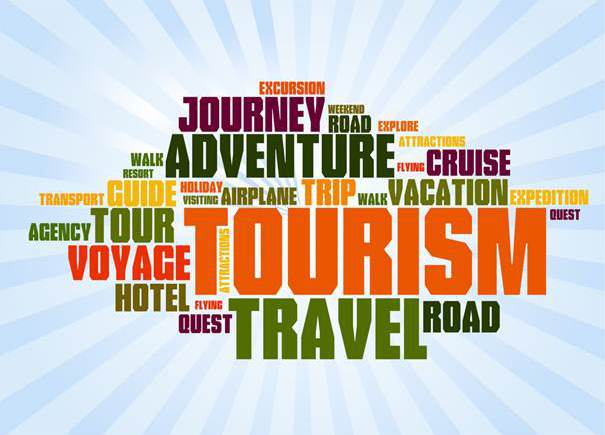
What are the 4 Ps of Tourism Industry

What is the garden leave policy in HR?

My New Book Release!
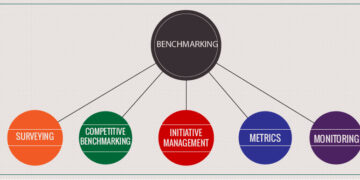
What is Benchmarking?
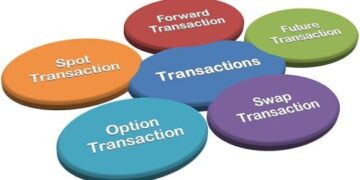
What are the different types of Foreign Exchange Market
Trending tags.

How to write an appropriate title

Can India regain the title of Vishwaguru?

What are the problems faced in online lectures?

What impact can Knowledge have on Society?

A Big Salute all our teachers!!!

What is Triple Helix Model for innovation?

Where in the world teachers are most respected?
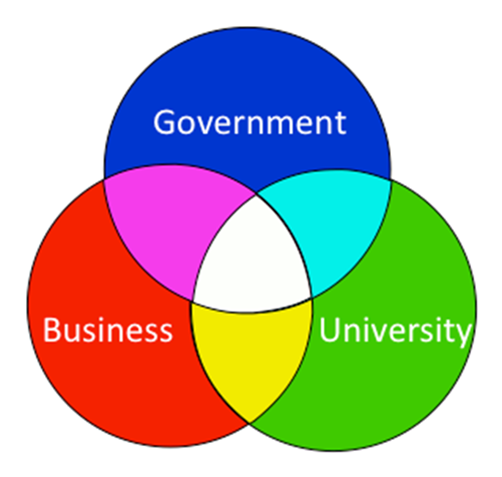
What is the Triple Helix Model for Innovation

Advantages of working on group assignments
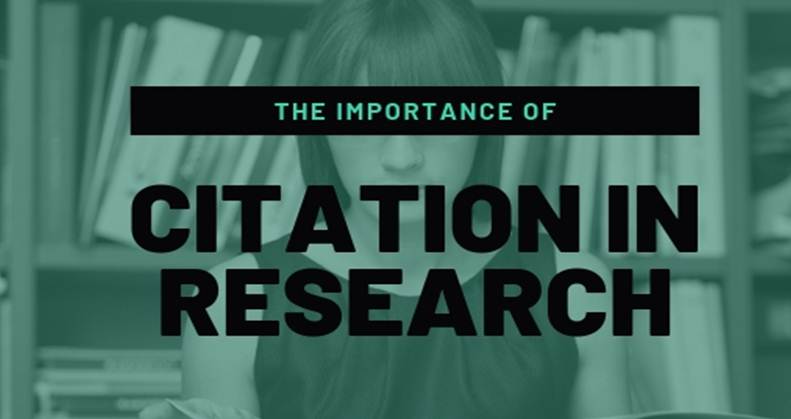
Importance of Citation in Research

What is Autoethnography style of PhD
Can scholarly articles/papers from blogs be cited in research work.
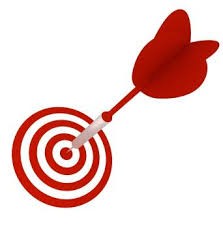
The complete guide on how to select the right PhD topic

All you wanted to know out how a PhD thesis is assessed?
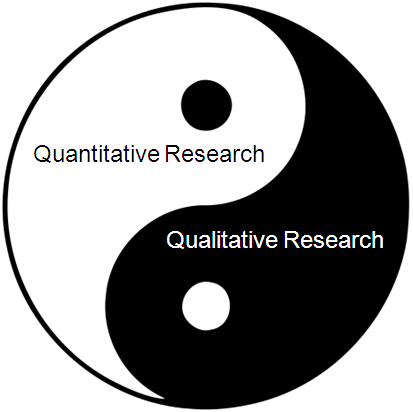
Mixed Method Research is Most Suitable
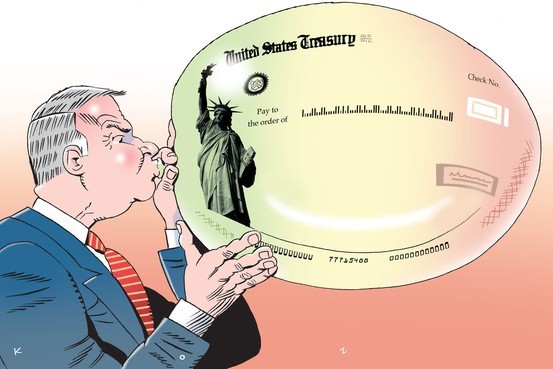
What is the difference between economic bubble and economic boom?

How to write a Research Paper?

Case Study is one of vital type of research

What is the Future of BRICS Currency?
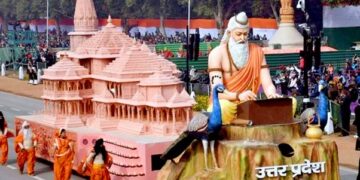
Ram Mandir tableau graced the 75th Republic Day of India

The rise of India as a Religious Tourism Destination
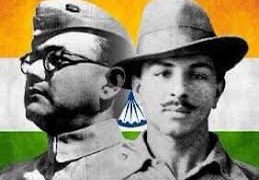
Why should our history be re-written?

Inspiring leadership of Malavika Hegde in managing crisis of Café Coffee Day CCD
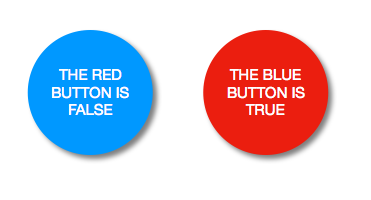
What is Protagoras Paradox?

What has Balbir Singh Seechewal done to be known as Eco Baba?
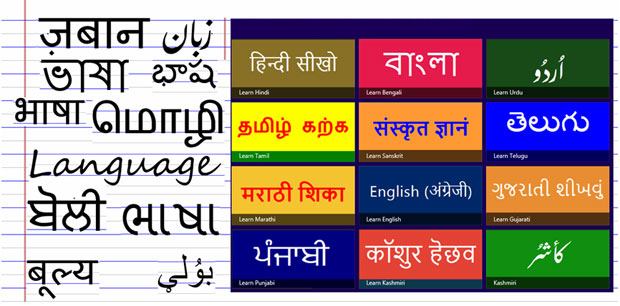
How the multilingualism of India helps
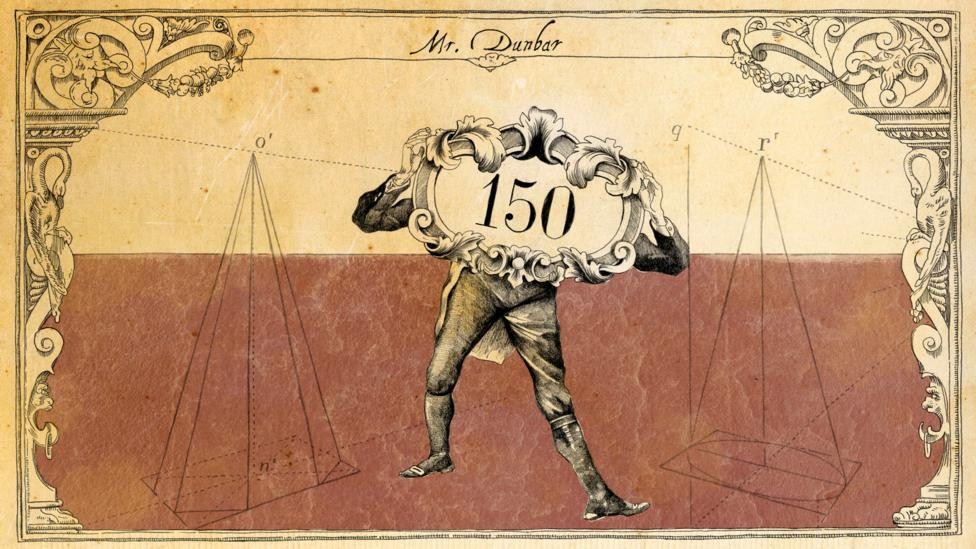
Limits of virtual friendship by Robin Dunbar

What’s your favourite spot in your house?

Developing unforgettable characters for movies

Why Pod Hotels are becoming a hit concept?
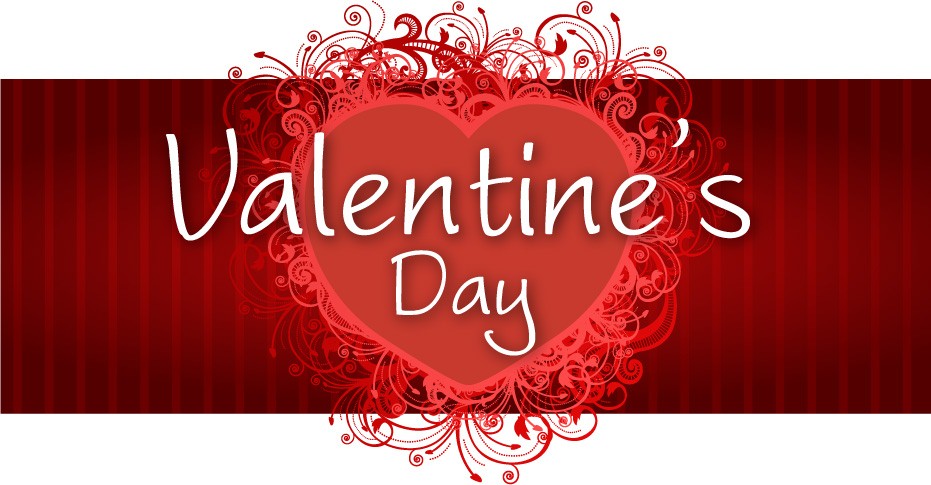
Do you know about the History of Valentines Day

When can you claim the title of a Polyglot?

Every Person You Meet has a Purpose in Your Life

Trust is the base of survival

Why some memories are stronger while some are forgotten?

One of my PhD students is working on her thesis titled “Marketing Strategies for Tourism Industry;’’ the University practices progress review on research every year. One of the panellists asked her to explain what her contribution to the research is, and what are the 4 Ps of tourism? My student has done a wonderful job; she tried explaining the 4 Ps, however, the panellist was not in a mood to listen to her explanation. How do we explain 4 Ps of tourism? Can we call tourism a tangible or an intangible product? The most accepted definition is provided by the World Tourism Organization (WTO), “tourism comprises the activities of persons travelling to end staying in places outside their usual environment for not more than one consecutive year for leisure, business and other purposes”.
Nevertheless, tourism is a very multifaceted industry which involves numerous stakeholders right from government of a nation, hospitality stake holders, and the nature (environmental factors) themselves – each contributing to either its growth or downfall.
Lets understand the 4 Ps of tourism:
In a marketing mix a product is any offering which satisfies customer’s requirement. Since tourism business is all about experience of TOURIST – this needs a different handling all together. It has to satisfy the tourist’s innate experiences .
Each tourist has his/her enigma; there are lot of tacit expectations of tourists. I personally think tourism as a product is complex in nature. It’s packaging matters.
Tourism products are rarely identical. This is because locations differ and also because of the people and the components that make up the experience provided to a traveler. It can be incredibly diverse and pricing strategies can evolve as a tourism destination develops. The pricing varies according to the package: uniqueness of the destination, what value added services are provided inclusive of the experience, which segment is being served (middle income/ high income/ low income) the operating costs (fixed and variable) and break even of the service provider.
For most tourism businesses setting prices will be market based. It is driven by what do competitors with similar products and services charge within a given market. Let me clarify here, preferably being price competitive is not price driven, its product driven. It also depends on the seasonality element. In sense, tourism business is seasonal in nature.
Tourism promotion uses a good promotional mix such as personal selling, advertisements in print media and electronic media, television etc. People prefer less-travelled destinations; these products require accommodations, transportations and infrastructural facilities of an international standard. Distinctive advertising strategies help to promote nation as a brand, which develops over so many choices in our world. Painting a tourism product in a positive light always helps in attracting potential consumers, and consequently the product consumed is the very essence of the advertising world.
To sum it up – sky is the limit for growth of tourism sector. The 4 Ps can be developed in manifold and can be mixed and merged beyond imagination.
Role of Colour Psychology in our Life
Dr vidya hattangadi.
© Copyright 2022 Dr. Vidya Hattangadi. All Rights Reserved.

- Global (EN)
- Albania (en)
- Algeria (fr)
- Argentina (es)
- Armenia (en)
- Australia (en)
- Austria (de)
- Austria (en)
- Azerbaijan (en)
- Bahamas (en)
- Bahrain (en)
- Bangladesh (en)
- Barbados (en)
- Belgium (en)
- Belgium (nl)
- Bermuda (en)
- Bosnia and Herzegovina (en)
- Brasil (pt)
- Brazil (en)
- British Virgin Islands (en)
- Bulgaria (en)
- Cambodia (en)
- Cameroon (fr)
- Canada (en)
- Canada (fr)
- Cayman Islands (en)
- Channel Islands (en)
- Colombia (es)
- Costa Rica (es)
- Croatia (en)
- Cyprus (en)
- Czech Republic (cs)
- Czech Republic (en)
- DR Congo (fr)
- Denmark (da)
- Denmark (en)
- Ecuador (es)
- Estonia (en)
- Estonia (et)
- Finland (fi)
- France (fr)
- Georgia (en)
- Germany (de)
- Germany (en)
- Gibraltar (en)
- Greece (el)
- Greece (en)
- Hong Kong SAR (en)
- Hungary (en)
- Hungary (hu)
- Iceland (is)
- Indonesia (en)
- Ireland (en)
- Isle of Man (en)
- Israel (en)
- Ivory Coast (fr)
- Jamaica (en)
- Jordan (en)
- Kazakhstan (en)
- Kazakhstan (kk)
- Kazakhstan (ru)
- Kuwait (en)
- Latvia (en)
- Latvia (lv)
- Lebanon (en)
- Lithuania (en)
- Lithuania (lt)
- Luxembourg (en)
- Macau SAR (en)
- Malaysia (en)
- Mauritius (en)
- Mexico (es)
- Moldova (en)
- Monaco (en)
- Monaco (fr)
- Mongolia (en)
- Montenegro (en)
- Mozambique (en)
- Myanmar (en)
- Namibia (en)
- Netherlands (en)
- Netherlands (nl)
- New Zealand (en)
- Nigeria (en)
- North Macedonia (en)
- Norway (nb)
- Pakistan (en)
- Panama (es)
- Philippines (en)
- Poland (en)
- Poland (pl)
- Portugal (en)
- Portugal (pt)
- Romania (en)
- Romania (ro)
- Saudi Arabia (en)
- Serbia (en)
- Singapore (en)
- Slovakia (en)
- Slovakia (sk)
- Slovenia (en)
- South Africa (en)
- Sri Lanka (en)
- Sweden (sv)
- Switzerland (de)
- Switzerland (en)
- Switzerland (fr)
- Taiwan (en)
- Taiwan (zh)
- Thailand (en)
- Trinidad and Tobago (en)
- Tunisia (en)
- Tunisia (fr)
- Turkey (en)
- Turkey (tr)
- Ukraine (en)
- Ukraine (ru)
- Ukraine (uk)
- United Arab Emirates (en)
- United Kingdom (en)
- United States (en)
- Uruguay (es)
- Uzbekistan (en)
- Uzbekistan (ru)
- Venezuela (es)
- Vietnam (en)
- Vietnam (vi)
- Zambia (en)
- Zimbabwe (en)
- Financial Reporting View
- Women's Leadership
- Corporate Finance
- Board Leadership
- Executive Education
Fresh thinking and actionable insights that address critical issues your organization faces.
- Insights by Industry
- Insights by Topic
KPMG's multi-disciplinary approach and deep, practical industry knowledge help clients meet challenges and respond to opportunities.
- Advisory Services
- Audit Services
- Tax Services
Services to meet your business goals
Technology Alliances
KPMG has market-leading alliances with many of the world's leading software and services vendors.
Helping clients meet their business challenges begins with an in-depth understanding of the industries in which they work. That’s why KPMG LLP established its industry-driven structure. In fact, KPMG LLP was the first of the Big Four firms to organize itself along the same industry lines as clients.
- Our Industries
How We Work
We bring together passionate problem-solvers, innovative technologies, and full-service capabilities to create opportunity with every insight.
- What sets us apart
Careers & Culture
What is culture? Culture is how we do things around here. It is the combination of a predominant mindset, actions (both big and small) that we all commit to every day, and the underlying processes, programs and systems supporting how work gets done.
Relevant Results
Sorry, there are no results matching your search., revamping the four p’s of marketing.
Learn about the 4 P’s that are the overarching marketing KPIs for our front office transformation.

Joining KPMG US in January 2020 as the CMO, I found the company on a journey to transform the front office using best-in-class Salesforce technology. Our goal is to improve how we develop, nurture, and manage client relationships across sales, service, and marketing. At the same time, we are re-aligning our back office processes so clients are the center of our focus.
One of my first tasks was to help our marketing organization optimize its structure and operating model to better serve clients. KPMG has three lines of business—audit, tax, and advisory—each maintaining its own strong, long-standing client relationships. We saw an opportunity for these businesses to work in a more integrated, collaborative way. To that end, we created Centers of Excellence to make partnering across marketing teams more organic. We can leverage central marketing expertise and employ best practices for all our digital and creative needs, connecting dots across service lines and representing the full breadth of KPMG to the market. Today, we can market ourselves as a single company, making it easier for clients to engage with us across all business lines.
Getting the most out of technology has much to do with how people work together. Our shift in how marketing is organized also prepares us to extract the most value from our implementation of Salesforce Marketing Cloud. While Salesforce is best known for its leading CRM technology, the company has spent more than a decade developing and acquiring a best-in-class marketing technology (or martech) offering. We’re onboarding the full Salesforce Marketing Cloud suite to benefit from the magic of front-office technology that seamlessly works to turbocharge the sales and marketing partnership.
Organizational and technology transformation can be overwhelming. I find it helpful to remind myself of what we aim to achieve, so we can focus on important outcomes. Taking our cue from the traditional 4 P’s of marketing, we’ve identified a new set of 4 P’s to guide us.
While it’s obviously important that the marketing team can now work together better, it’s even more critical for marketing and sales to collaborate. Over the last year, my priority has been creating stronger processes and communication with Julia’s sales team. When COVID made digital marketing mandatory for the business, we quickly stood up a lead management and distribution process. This provided a consistent way to hand all leads—from online interest forms to webcast attendance—seamlessly to sales.
I believe the fundamental difference between sales and marketing arises from a lack of shared metrics of success. Marketers fixate on top-of-the-funnel (TOFU) activities, while salespeople hone in on BOFU and converting opportunities to closed deals. When our sales and marketing orgs share data on the entire sales funnel and work toward common goals, KPMG will be positioned for maximum productivity and growth.
2. Priortize
Marketing is fundamentally about understanding customers; we can’t do our jobs without knowledge about what our customers need. Yet in so many organizations, KPMG included, marketers create overlapping, “spray-and-pray” programs that inundate our target audience. CRM data collected by Salesforce technology will provide KPMG marketers visibility into customers and the pipeline, so we can better support our sales colleagues by creating tailored, targeted messaging and sales materials.
3. Personalize
Today’s customers—whether B2C or B2B—expect personalized experiences. The more information marketing can extract from CRM, the more personalized campaigns can be. Salesforce will enable us to automate personalized outreach so that KPMG account teams can be even more proactive in helping clients meet challenges.
Right now, KPMG has little insight into which marketing activities are connected to closed sales because our analytics are based on a last-touch attribution model. When Salesforce provides data and insights into the tactics that work, we’ll plan campaigns with more confidence, and most importantly, live up to marketing’s true raison d’etre: to generate growth.
These new 4 P’s are the overarching marketing KPIs for our front office transformation. We’ve got the right people and team structure; soon, we will have the right technology to complete the process of focusing marketing on the client.
Discover our alliance
Kpmg and salesforce.
Connect to your customers with speed, scale, and intelligence
Meet our team
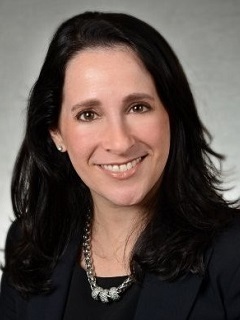
Thank you for contacting KPMG. We will respond to you as soon as possible.
Contact KPMG
By submitting, you agree that KPMG LLP may process any personal information you provide pursuant to KPMG LLP's Privacy Statement .
Job seekers
Visit our careers section or search our jobs database.
Use the RFP submission form to detail the services KPMG can help assist you with.
Office locations
International hotline
You can confidentially report concerns to the KPMG International hotline
Press contacts
Do you need to speak with our Press Office? Here's how to get in touch.

IMAGES
VIDEO
COMMENTS
The 4 P's Of Marketing In The Travel & Tourism Industry. Product, Price, Place, and Promotion are the four key points in any tourism business' marketing strategy. Product. Unlike other businesses, where the product is a material item or tangible thing, the products in a travel company are not. But the basic aim is the same: Providing a ...
Promotion: In tourism, the promotional activity consists of inspiring, educating, persuading, and reminding the travelers about the brand or product. It refers to the marketing tactics employed to spread brand or product awareness. Various digital channels, including traditional, OTT, and CTV devices, are used in the tourism industry.
the sixth of the 7 Ps of tourism marketing is the process. The process that a customer goes through from the moment they book your activity to when they finally complete the tour should be as pleasant, convenient, and seamless as possible. Customers should be able to access any information they need with ease including their itinerary, booking ...
For tourism marketing there are an additional 4-Ps (Morrison et al., 2018): Packaging - A way to purchase some, many, all of the tourism product together (often through intermediaries such as Travelocity, Expedia, etc.). ... The differences would include the marketing mix or 4-Ps of marketing (i.e., product, place, price, promotion).
It is a combination of tangible and intangible elements. A destination is a "product" in tourism. From the marketing mix point of view, since the travel business is all about the 'tourist' experience, this is required to be treated differently. 2.2. Price. Price is a crucial factor in the 4Ps of travel and tourism.
Pricing. Place. Product. Promotion. Which of the four Ps matters most to a destination marketer? Typically, a DMO has little control over pricing and place. Promotion has changed drastically as a result of technology that accelerates word-of-mouth communication and shifts control over the messaging toward the consumer.
Standing out from the crowd means rising above the clutter and noise. Often, simplicity is the key to honing a focused and clear marketing strategy. A fundamental step begins with understanding the 4Ps of tourism marketing. These four key factors provide a reliable method for shaping your branding, promotions, social media presence and digital ...
Having a marketing strategy means having plans in place to deal with both expected and unexpected situations. A marketing strategy helps you position your product to the right audience, at the right time for the right price. You should build your marketing strategy around the "Four Ps" of marketing: Product: The goods or services you offer.
Tourism Marketing Mix (The Four P's) Today, 10.4% of the world's GDP and 7% of the world's total exports come from tourism. The industry is worth over US$ 1.1 trillion. The money earned from expenditures by foreigners are crucial drivers of economic development and can be an important source of foreign exchange. ... Furthermore, it will ...
A fundamental step begins with understanding the 4Ps of tourism marketing. These four key factors provide a reliable method for shaping your branding, promotions, social media presence and digital marketing initiatives. Within this framework, each 'P' represents a crucial facet, starting with 'Product', followed by 'Price', 'Place' and finally ...
How to write a tourism marketing plan. 1. Run a SWOT analysis. A SWOT analysis is a fun exercise that identifies your company's S trengths, W eaknesses, O pportunities, and T hreats. Strengths and Weaknesses are internal factors that you can control, like your team, resources, and location.
The four Ps of marketing are product, price, place, and promotion. These are the key factors that are involved in marketing a product or service. You take the four Ps into account when creating strategies for marketing, promoting, advertising, and positioning your product or brand. The four Ps are meant to help marketers consider everything ...
The 4 P's of Marketing: Bridging Tourism and Marketing Fundamentals. Product: Crafting Unforgettable Experiences. The tourism sector is unique; the product is the experience. It could be the tranquil retreat to a beach resort, the thrill of a safari adventure, or the opulence of a five-star hotel. Understanding and enhancing the services ...
The four Ps of tourism—product, price, place and promotion—can be developed in myriad ways ... Product: This is the first element of the marketing mix. Tourism as a product differs from other ...
Updated November 2021 - Anyone who runs a business or markets a specific product within the tourism industry knows about the tourism marketing mix.The traditional marketing mix was created in 1960 and has been applied to nearly every product created since then. The marketing mix contains the 4 P's: product, place, price, and promotion. However, 3 extra P's apply for the experiences ...
Optimizing customer experiences on all marketing channels is crucial. 15. Embracing content and influencer marketing. Content and influencer marketing are essential building blocks of any successful tourism strategy. It helps in optimizing the presence of a travel business in the search engine.
Four Ps: The four Ps are the categories that are involved in the marketing of a good or service, and they include product, price, place and promotion. Often referred to as the marketing mix, the ...
The five Ps. The five Ps are product, price, place, promotion, and people . Today, many marketers use the five Ps over the four Ps because they center the experiences of customers and staff in the marketing process. Typical considerations include how a customer behaves, their product experience, and overall satisfaction with the business.
The 4 Ps—product, price, place, and promotion—and the 4 Cs—consumer, cost, convenience, communication—are both examples of marketing mix models. They both aim to boost sales, but the 4 Ps is more focused on the internal processes of the marketing strategy while the 4 Cs is more focused on the external processes that may influence a ...
Tourism marketing, just like any other form of marketing, relies on the 4Ps - Product, Price, Place, and Promotion. These are the key elements that play a crucial role in shaping the marketing strategy for tourist destinations, travel agencies, and hospitality businesses. **Product:**. When it comes to tourism marketing, the "product ...
The tourism business is highly hyper competitive in nature. The tourism destinations are faced with a rapidly changing surrounding, nature and increasing demands from travelers. It requires adaptable and workable marketing strategies. The 4 Ps can be developed in manifold and can be mixed and merged beyond imagination.
The aim of t his study was to assess the relationship between tourism marketing mix, 4Ps (product, price, process, and promotion) and tourism development. This. assessment was carried out by ...
Taking our cue from the traditional 4 P's of marketing, we've identified a new set of 4 P's to guide us. 1. Partner. While it's obviously important that the marketing team can now work together better, it's even more critical for marketing and sales to collaborate. Over the last year, my priority has been creating stronger processes ...